Public Pier — No Fishing License Required
The angling piers of California are unique. At Redondo you find a little shop at the entrance with long rods and tackle to rent, and not far away the bait man, ready to provide clams, small fish, or anything you wish. Long Beach has several piers, and at Venice the pier is virtually a city street built out over the sea, with shops of various kinds and entertainments sufficient to divert the attention of the ghost of Walton. At the long, mile or more pier at Santa Monica a house stands at the sea-end, far out to sea, and the rail is lined with anglers who employ strange tackle. A little shop provides simple cheer to the physical man, and tackle can be rented and bait purchased. Back of the shop hangs a big scoop-net forty feet square, which is occasionally lowered and live bait caught, which is sold to the anglers whose ambition soars above sand-dabs and mackerel to the other realms of yellowtail or big sharks, or a possible ray.
—Charles Frederick Holder, Salt Water Game Fishing, 1914
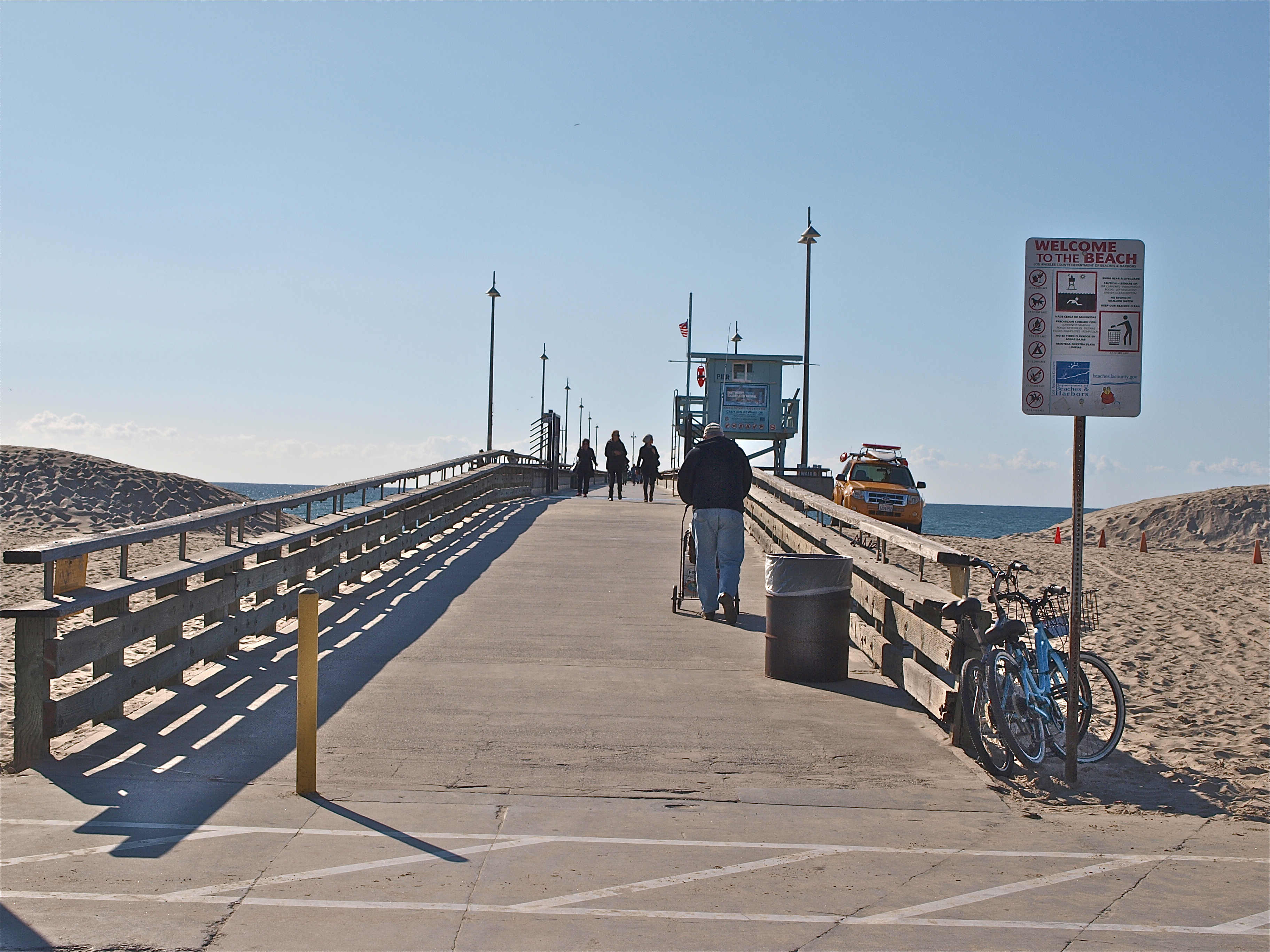
The entrance
Venice, California, in the old days had much to recommend it to people who liked to be sad. It had fog almost every night and along the shore the moaning of the oil well machinery and the slap of dark water in the canals and the hiss of sand against the windows of your house when the wind came up and sang among the open places and along the empty walks.
Those were the days when the Venice Pier was falling apart and dying in the sea and you could find there the bones of a vast dinosaur, the rollercoaster, being covered by the shifting.
—Ray Bradbury, Death Is A Lonely Business, 1985
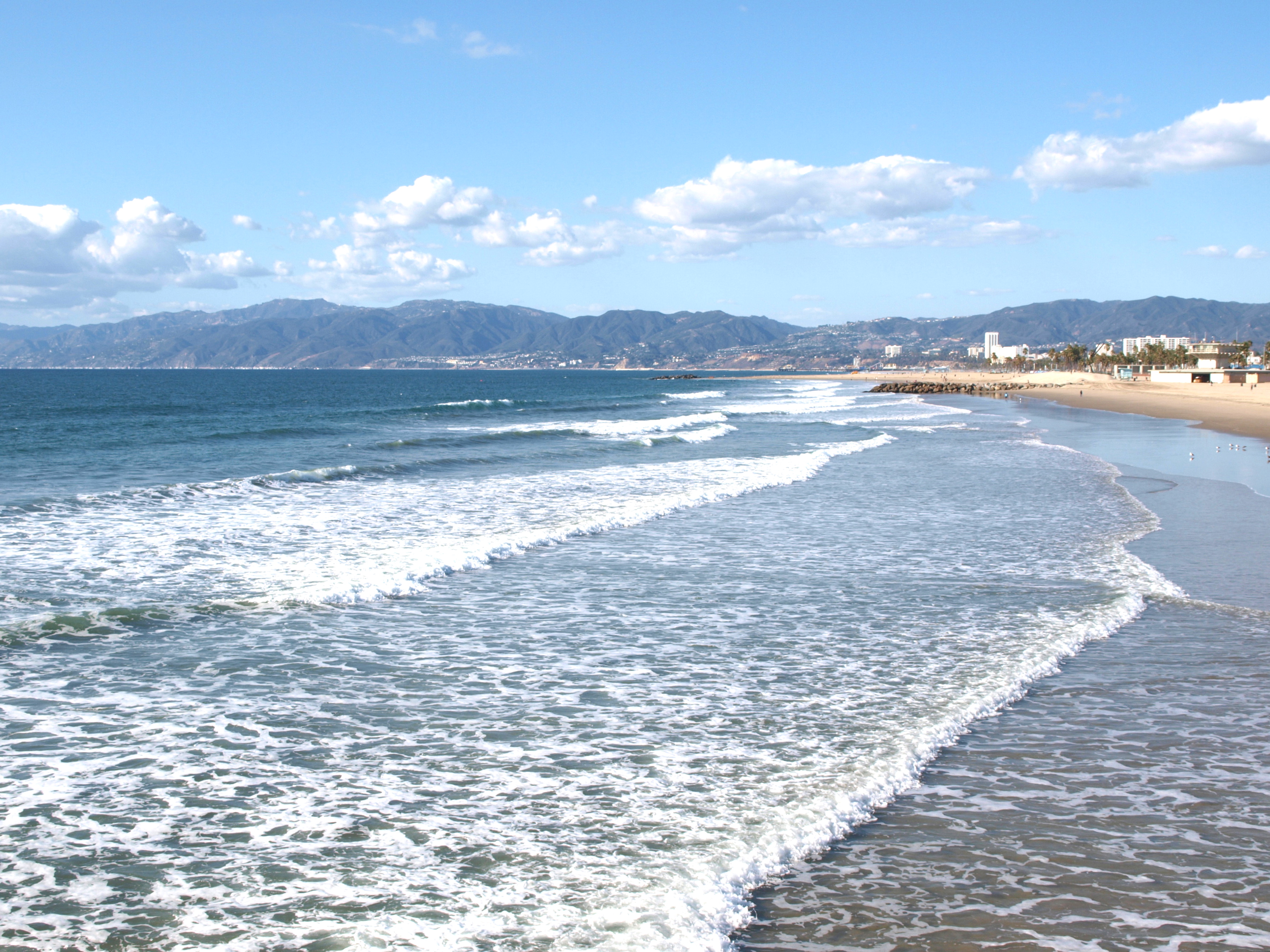
The surf and coast
These two quotes, one from more than a hundred years ago, and one from only a few decades ago, reflect a different pier, the original Venice Amusement Pier of Abbot Kinney. That pier was huge, and part of a social experiment that was intended to make Venice a cultured Renaissance town in America. But Kinney also wanted to make money and the pier he built was, in many ways, as crass as a county fair (but on a much, much larger scale).
But the dinosaur rose, and fell, and the social experiment itself died a messy death. Its death left Venice a town that has always seemed a little different, a home for the beatniks in the fifties, the hippies in the sixties, and various groups since those days.
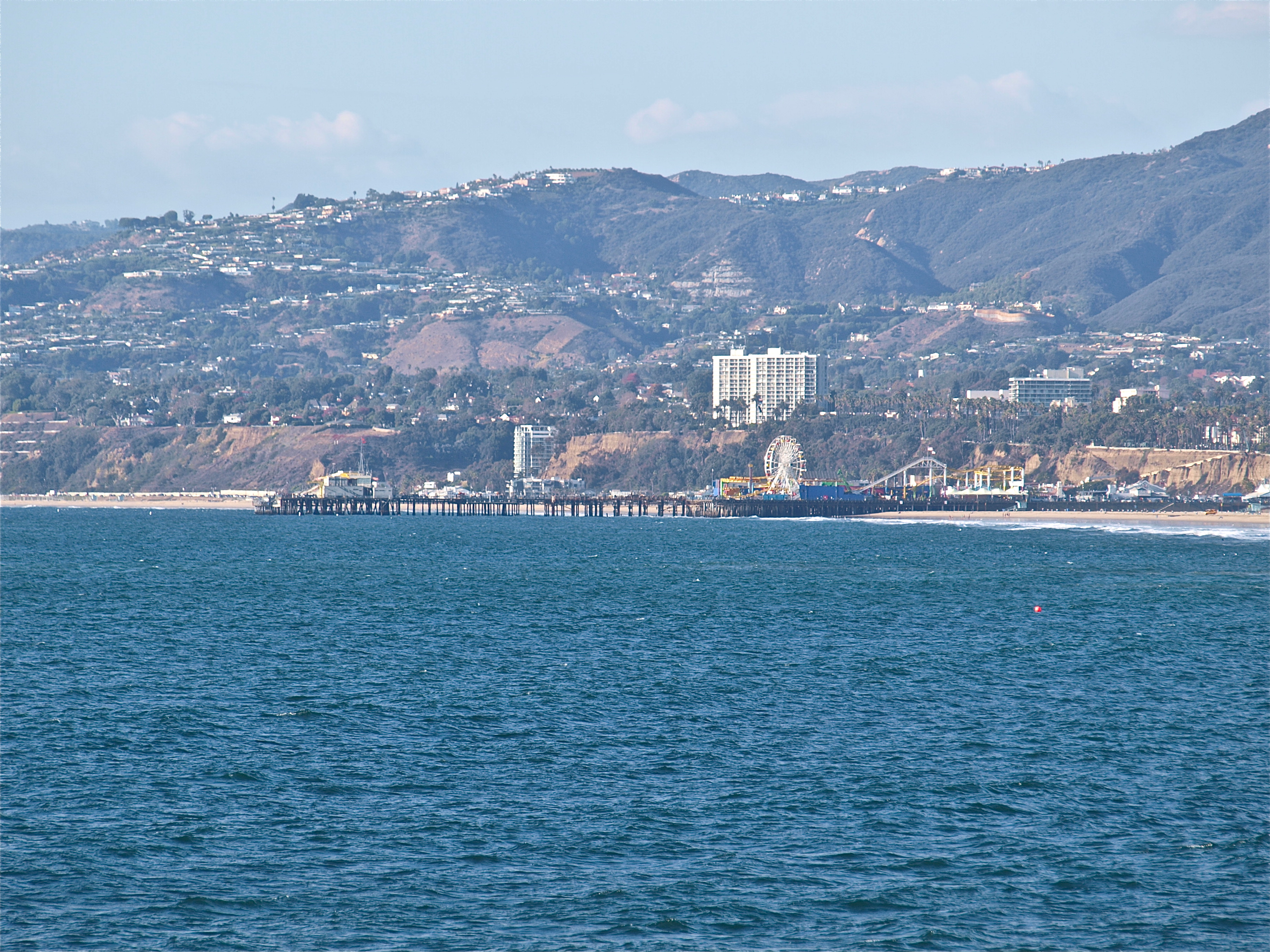
The Santa Monica Pier sits just a short distance up the coast
As for the fishing pier, it’s different. The original pier may have allowed anglers to drop a line into the water but it never was designed as a fishing pier. In contrast, today’s pier has one purpose: fishing, and luckily the fishing can be quite good.
Sometimes things seem so simple that you wonder why no one else thought of the same idea. That was my thought when I visited the “new” Venice Fishing Pier in the summer of ‘98. Among the neat little touches that the designers had given the pier were two that every pier should copy. The first was a double railing out at the end of the pier. The bottom railing can be utilized for cutting bait, which means the top railing, the railing usually used by fishermen and other visitors to rest their arms, needn’t become coated with slime and dried blood. A nice touch!
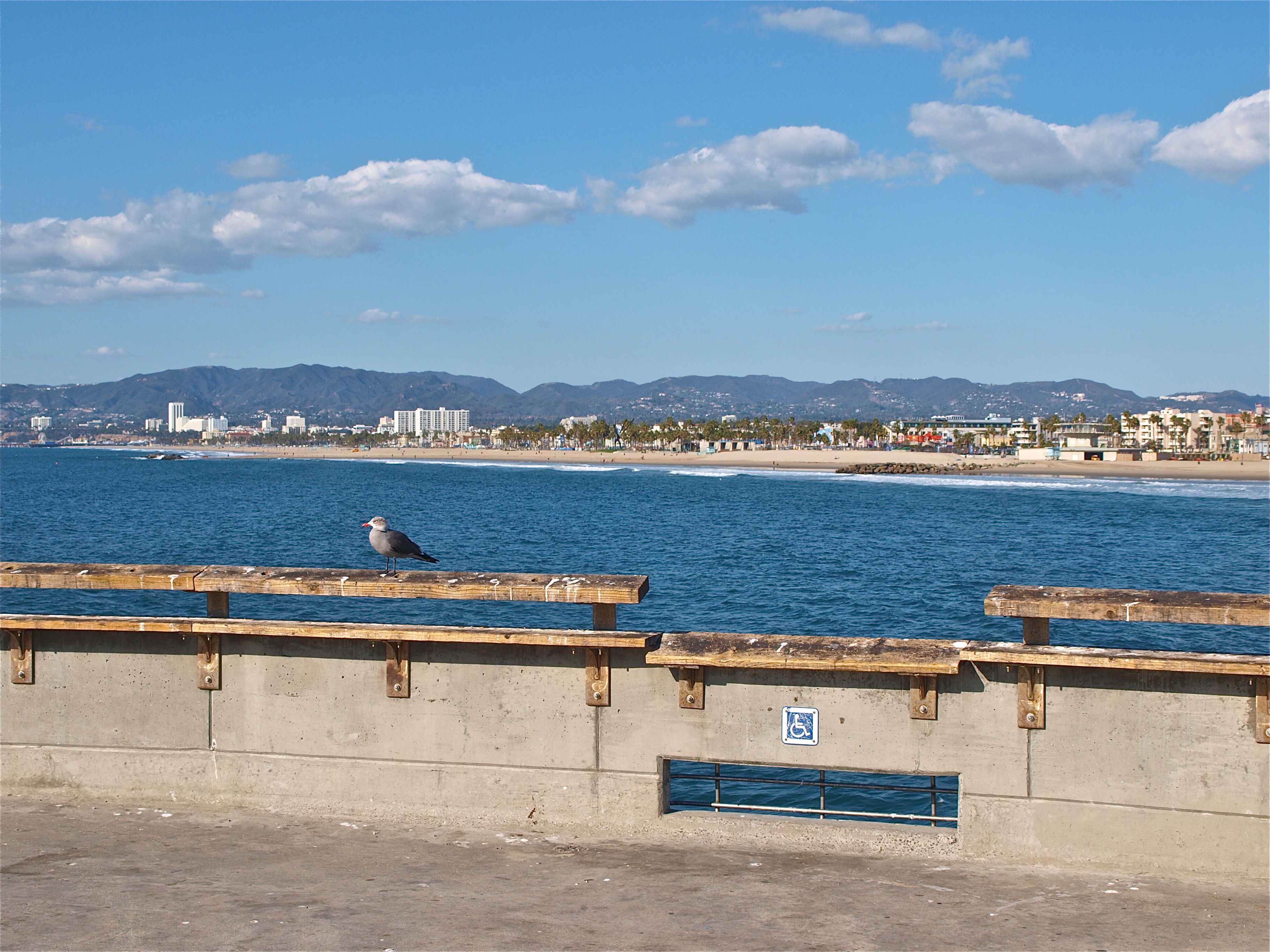
Another great idea was the cutout sections found at various points on the pier, sections that have a lower 28” railing than the other 41” areas. It took me a minute to understand the purpose but then I noticed the handicapped signs and realized that these lower sections were designed for people in wheelchairs. Most piers have railings that range from 38-42 inches, a height difficult to use for people in wheelchairs. The decreased height of these sections, even if only 12 inches or so, helps compensate and make the fishing more accessible to all anglers. Now, how about more piers copying those ideas!
A third touch, perhaps good, perhaps bad, was the light fixtures, pointed in the middle and designed to keep sea gulls from landing on them. It may prevent sea gulls from landing on the lights but that may simply mean more birds landing on the railings. Of course matching lights were also installed along the Ocean Front Walk and I imagine they are a good idea in that area.
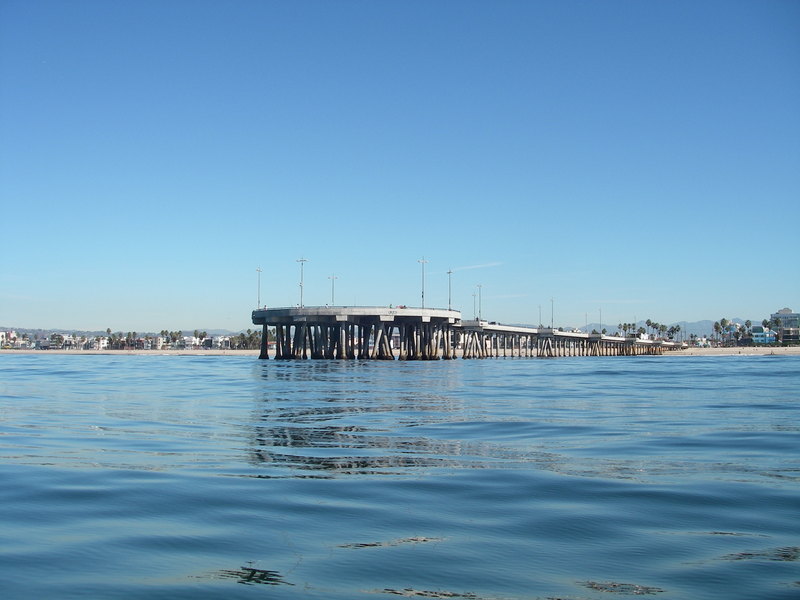
Environment. The pier, although fairly new, is actually a reconstructed version of the Venice Pier built in 1965. The pier, damaged by the El Nino storms of 1983, saw structural damage that necessitated rebuilding and/or repairing all of the deck (while retaining most of the existing pilings). Wise move! The pier is heavily used by the citizens of Los Angeles and its predecessor was in fact called the Los Angeles Pier for a time (although rarely by the locals).
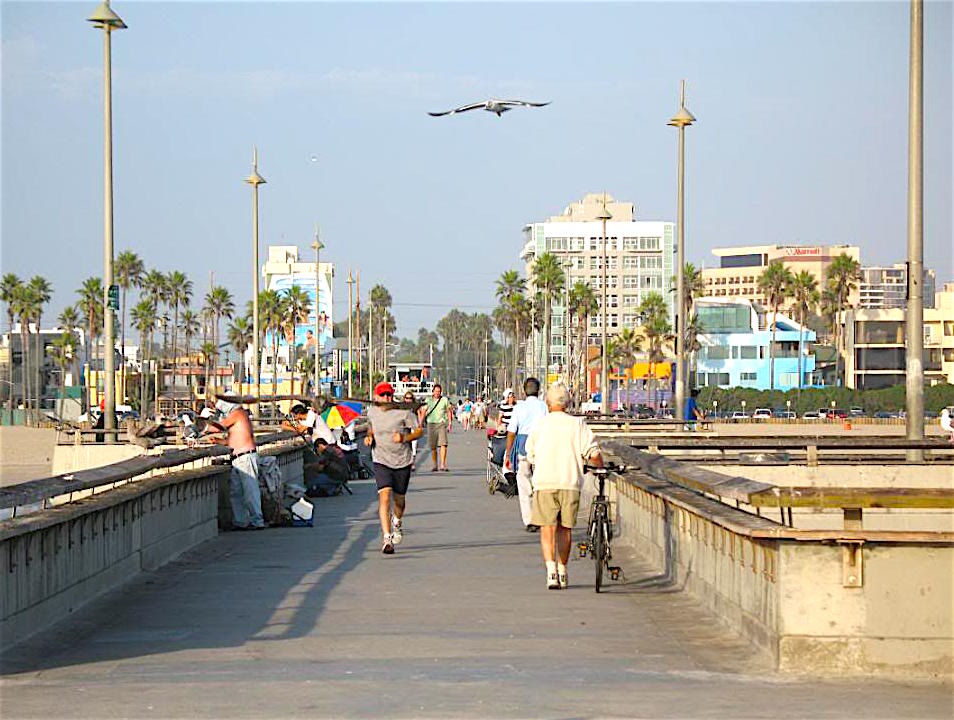
The pier itself is concrete and has a good growth of mussels on the pilings. The bottom is primarily sand but a 4,000-ton, artificial quarry-rock reef was placed around the outer 750 feet of the old pier in 1966 and should still be present. The sandy areas produce fairly consistent sandy-shore species while the reef helps attract fish that prefer a rock-dwelling environment.
To the southeast sits the rocky-jetty entrance to Marina Del Rey (with boats coming and going all hours of the day); small finger jetties jut out to the north of the pier. The pier has a 120-foot diameter circular end, which provides considerable space for anglers, and the length, at 1,310 feet, assures access to a little deeper water and the pelagic species.
Although Venice is one of the busiest piers in the southland, and often downright crowded, the pier normally seems to have a friendly, laid back, laissez faire atmosphere. It’s an amazing contrast to the nearby helter-skelter, free spirited activities just a short distance up the beach. And though the pier sees an amalgam of races, ethnicities, cultures, and languages (English, Spanish, Chinese, Tagalog, Russian, Farsi, Greek, Vietnamese, Korean, etc.), the people seem, for the most part, to all get along. Perhaps it’s the shared vision and dreams of catching “the big ‘un.”
Of course like any crowded pier, and this pier is often crowded, there may be a few knuckleheads in the mix. Don’t let crossed lines, overhead casters, or simple intemperate cretins ruin your fun.
The pier is located in the Venice (Muscle Beach)-Playa Del Rey area where there always seems to be something a happening, either on the beach itself or on the famous boardwalk (Ocean Front Walk). The beach with its body builders, weight lifters, and drum circles does get attention (Lonely Planet, 2005, says “Get your freak on at LA’s most hipsterrific beach”), but it’s the boardwalk that stretches between Venice and Santa Monica that’s truly amazing. The boardwalk’s a crowded, funky scene made up of street performers (including a chain-saw juggler and a fire eater during my last visit), snake charmers, roller-skating prophets, fortune-tellers, multi-colored hairdos, and wacky, stranger than strange tattoos. LA’s own website calls it a “sidewalk circus, a walk ‘n’ rolling skin show.” Lonely Planet says, “It’s a freak show, a human zoo and a wacky carnival.” I’ve often thought it analogous to the scene on the back of Bob Dylan’s Basement Tapes album.
Most of the action is interesting—and safe—but there’s also some persistent beggars and hair-brained druggies willing to stick their face in your face. Be cautious. The entire area is a place where activity is usually non-stop late into the night and it’s also a must see attraction for many visitors to Los Angeles (and one reason why parking can be a nightmare).
Even though most of the wild action actually takes place roughly a half-mile up-shore from the pier, the crowd overflows and a fisherman can, at times, look just a little bit out of place. Imagine our fearless angler, loaded down with rod and reel, tackle box, bait buckets, etc., as he winds his way onto the pier between iPod-attired line-skaters, bikini-clad goddesses, Schwarzenegger imitators, and perhaps just a little flotsam and jetsam blowing in the wind. What a sight! But, have no fear, our trusty angler will make it out to the pier to share time with fellow fisher-folk and hopefully catch a variety of fish.
The Fish. Fish surveys done by the Department of Fish an Game between 2004 and 2009 showed the pier to have a very typical mix of SoCal, sandy-shore beach pier fish (25 species). The fish (numerically) — Pacific sardine, Pacific mackerel, white croaker, jacksmelt, shiner perch, queenfish, jack mackerel, walleye surfperch, yellowfin croaker, queenfish, Pacific bonito, barred surfperch, topsmelt, white seaperch, thornback ray, barred sand bass, black perch, pile perch, Pacific barracuda, California halibut, California corbina, spotfin croaker, California butterfish, shovelnoe guitarfish and California lizardfish.
However, some exotic fish do show up. Noted fishing writer Steve Carson sent me a note discussing the inaugural years of the pier and a very unusual fish: “during the first three years of Venice Pier’s operation, 1965-66-67, ‘Ratfish’ were fairly common; I can recall at least one day when about 10 were caught, but none after 1967.” The Pier Fishing in California message board recorded the catch of a yellow snake eel in November of 2006—out at the end of the pier.
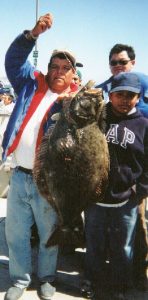
Big California Halibut
Inshore, the most common fish will be corbina, barred surfperch, spotfin and yellowfin croaker and a variety of small sharays — round stingrays, thornback rays and small leopard sharks.
In the mid-pier area, anglers catch white croaker (tomcod), queenfish (herring), walleye surfperch, shinerperch, shovelnose guitarfish, Pacific sardines, Pacific mackerel, jack mackerel, jacksmelt, lizardfsih and California halibut. The ambush-predator halibut like to hang out in the depressions between the pilings. There they lay, almost indistinguishable from the sand, and looking up from the eyes on their topside. When an unsuspecting queenfish, smelt or other small fish makes the mistake of entering their zone, they shoot up and grab them.
The pilings themselves, and the small critters hanging on and about them, attract a plethora of perch and perch-like fish including blackperch, rubberlip seaperch, halfmoon, large opaleye and zebraperch. Unfortunately, the vegetarian zebraperch and its (sea chub) family cousin opaleye can be hard to catch.
At the large, circle-shaped end of the pier, anglers encounter some of the same species as in the mid-pier area but see additional species due to the artificial reef surrounding the end. Kelp bass and sand bass will show up as well as an occasional rockfish, rock wrasse, senorita, and (if you’re very lucky) maybe even a sheephead. More mackerel are caught, bonito and barracuda are taken (some years), and larger sharays are seen.
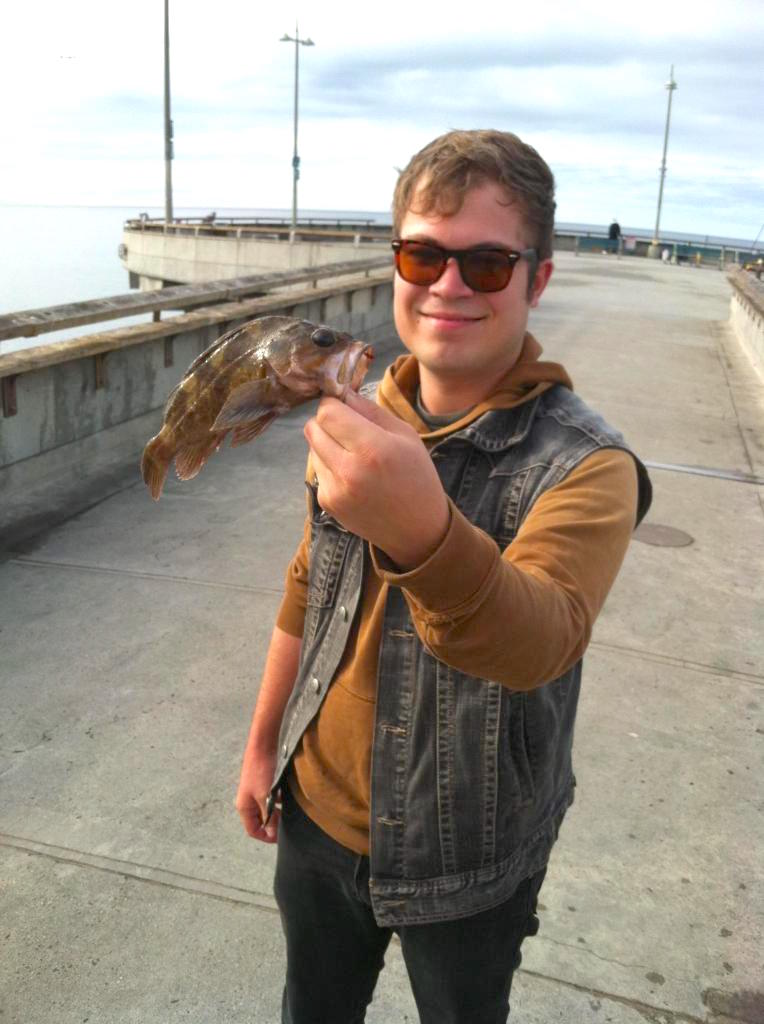
Rockfish
Included in the shark/ray catch are the usual big ‘uns—leopard sharks, shovelnose guitarfish and bat rays—but the pier also sees a few of the even bigger Selachians (sharks), species like soupfin sharks, thresher sharks, mako sharks, and even great whites. An approximate five-foot-long mako was taken in September 2008 while threshers make sporadic appearances; a 100+ pound thresher was hooked in July of 2005; a good run of threshers, including fish to eight feet in length were taken in May of 2008. Several great whites have been reported in the Manhattan Beach-Venice area and a young great white was hooked from the pier in September of 2011, brought to the surf, and carefully unhooked. The release was filmed and onlookers can be heard oohing and ahhing and calling for release of the poor little fish (aka maneater shark). Relatively uncommon, but occasionally seen, are horn sharks, angel sharks and electric rays.
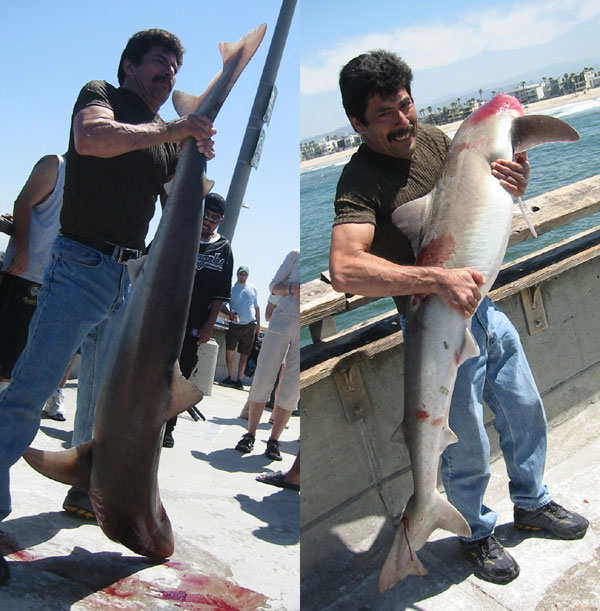
Not a great picture but a nice soupfin shark
Increasingly, as the big fish make a comeback, giant (black) sea bass are also being hooked from the pier. Remember that they are illegal and that they must be handled carefully (if at all) and returned quickly and gently to the water (if netted). Such was not the case in August of ’08 when a 20-pound or so youngster was brought up to the pier (a video of which showed up on several web sites). Of course everyone needed to take a picture with his or her cell phone before the fish was released (although a voice in the background can be heard urging people to “release it before it dies”). Finally the hook was removed, picture taking was at an end, and the fish was lifted up over the railing and dropped back down into the sea below. As might be expected, with all the time delay and mishandling, the fish didn’t survive the episode. El dumbo!
Fishing Tips. In the surf area, anglers can fish with a light line, a high/low leader, and number 6 or 4 hooks baited with sand crabs (especially soft shell crabs), bloodworms, fresh mussels or ghost shrimp to catch barred surfperch, corbina and yellowfin croaker. Somewhat heavier line and rigging, baited with fish or squid, can produce sharks and rays, mostly leopard sharks, round stingrays, and thornback rays. A fish-finder, Carolina-type leader can also work for all these species while barred surfperch are almost always agreeable to a Berkeley Gulp Camo Sand Worm or a motor oil grub.
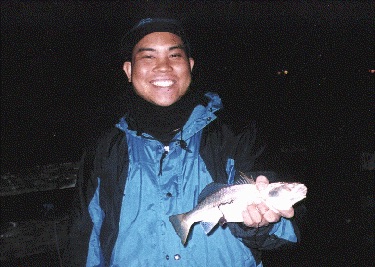
Corbina
Of note was an interesting run of 3-5-foot-long leopard sharks in the inshore waters during October of ‘99. Although leopard sharks are common, what was unusual was the report of large numbers of leopards being caught by anglers using live crabs, including sand crabs. The Bible on leopard sharks typically says to use mackerel or squid but these babies evidently wanted something a little more Epicurean to their taste. During the same month there were several stories of large numbers of leopards massing in shallow waters along the San Diego coastline. A similar run of sand crab-eating leopards took place at Santa Monica in July of ’08. Perhaps the book on their food needs to be changed?
The mid-pier section is home to several small species. Fishing on the bottom away from the pier while using a high/low leader, and size 4 hooks baited with cut anchovy, squid or strips of mackerel, can be good for white croaker (tomcod). Fishing mid-depth under and around the pier with bait rigs (Sabiki/Lucky Lura, size 8 hooks) can result in queenfish (herring) and walleye surfperch. If action slows, bait the hooks with small strips of anchovy, pieces of worm or even small pieces of squid. Schools of Pacific butterfish (pompano) and salema may also show up and if they do, baited bait rigs will usually do the job. Both species love small pieces of fresh mussels and sea worms like bloodworms and lugworms.
Just past the breakers to mid-pier is the home to most of the halibut and fishing on the bottom, in the depressions between the pilings, is often the best spots for the flatties. Fish with live bait (anchovies, queenfish, smelt, sardines, shinerperch or baby mackerel). Although plastics can be effective for halibut in this area, crowds at the pier can make the use of such artificial lures difficult.
Mid-pier to the end can also see mackerel, bonito (some years) and barracuda (usually in the Fall). Mackerel are most commonly taken on bait rigs, baited or unbaited, but if they’re not in a biting mood a piece of mackerel or strip of squid fished under a split-shot sinker may entice them. Often the macs will show up in the evening hours as soon as it is dark and at such times bait fished under a glow light will produce fish when nothing else seems to work. Most of the barracuda will be taken on spoons such as Kastmasters and Krocodiles (although MegaBaits are also gaining a following). Bonito will hit a variety of lures although the tried and true feather behind a Cast-A-Bubble still seems best for many.
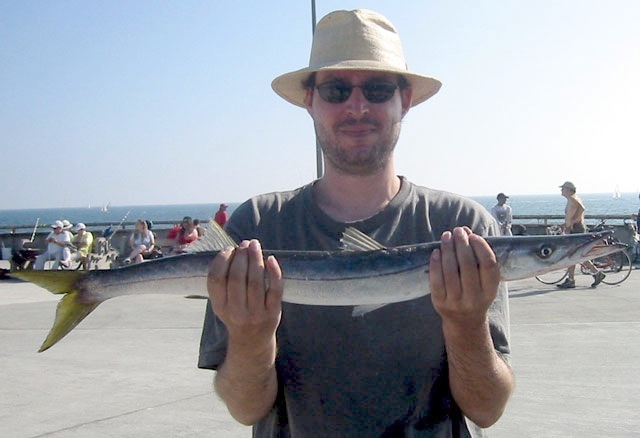
Nice barracuda
On the west side of the pier, just before you get to the end, is where the restrooms used to sit. They fell from the pier in 2005 and the remains still sit on the bottom under water. It’s a great place to tangle up and lose your line but it’s also a place where fish like to hang out, especially sculpin (scorpionfish). If you’re willing to take the risk give it a try using cut squid or shrimp on a one hook leader.
At the end, similar techniques are used as further inshore. However, with the reef only 65 feet from the pier, anglers often try for larger fish. Fishermen should use one of the bonito riggings when schools of bonito show up and heavy tackle, at least 40-pound test, when trying for larger sharks and bat rays.
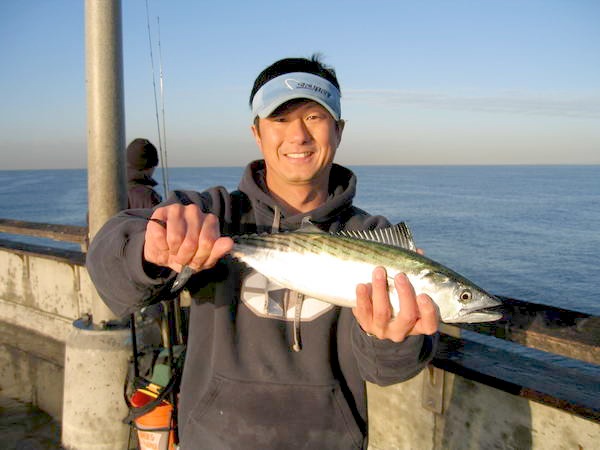
A nice bonito.
Fishing with a live bait leader baited with a small jack mackerel (Spanish mackerel), baby Pacific mackerel, sardines, queenfish, or shinerperch can sometimes yield small white seabass while warm water months may even see a few yellowtail landed. Although many resident species can be caught year-round, the best action for the pelagics is generally from June to October.
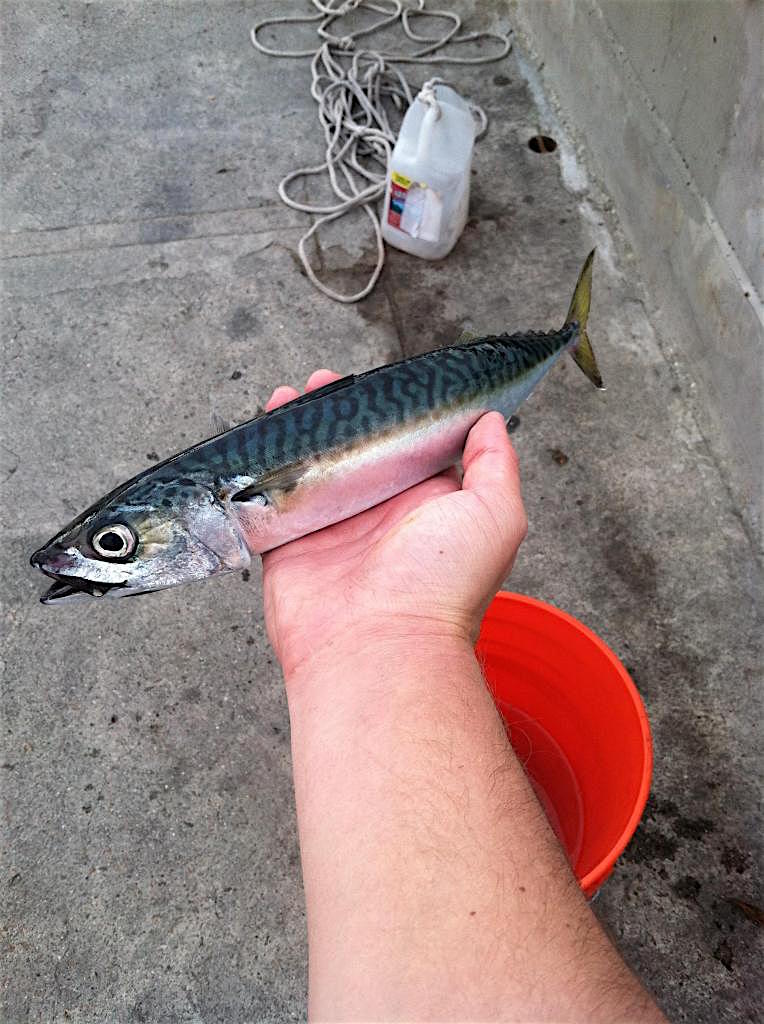
Pacific Mackerel
The end area is also where the “shark” anglers fish, at least those seeking out the larger sharks. It’s not a noted pier for sharks but enough big bat rays (mud marlin), shovelnose sharks (guitarfish), leopard sharks, soupfins, and threshers are caught to keep it interesting. If specifically seeking out the larger sharays come prepared with a medium to heavy rod and reel, 40-60 pound test line and a 6/0 to 7/0 hook. For the bat rays use a big piece of squid; leopards, guitarfish and soupfins prefer a bloody piece of mackerel or sardine—or a live fish; the threshers typically are caught on live mackerel, sardine or jack mackerel fished on a sliding leader (trolley rig). Most of the sharks are caught at night but threshers often hit best in the afternoon, especially when there’s a little chop on the water.
Since shark fishing is best at night, one recommendation is to be in a group if seeking out the sharays. There’s usually not too much of a problem on the pier but it’s not that uncommon to be accosted by the homeless as you leave the pier (some sleep under the pier) or drunks wandering over from the bars on Washington Street.
Although never really noted as a great producer of lobsters, the nearby reef does attract some of the spiny crustaceans to the area of the pier. Proof is seen in the capture of a 5 1/2 pound beauty on Labor Day weekend in 2000 that could not be kept since it was out of season.
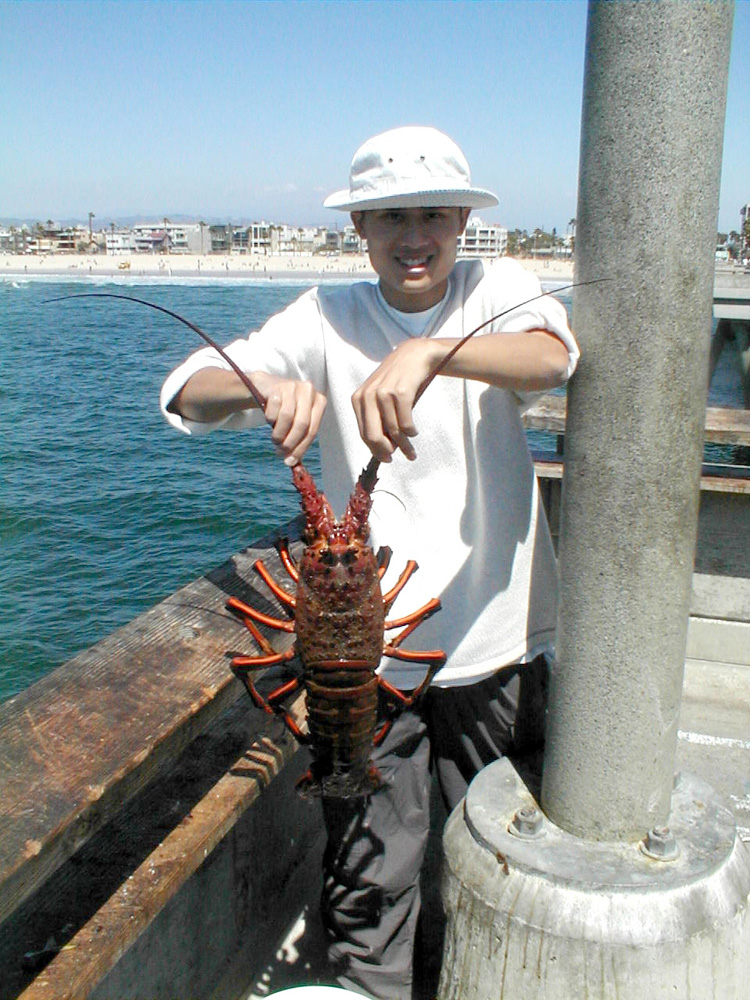
Lobster
The Pier Rats Speak — A Bakers Dozen Posts to the Pier Fishing In California Message Board
Date: Jun 23, 2000; To: Pier Fishing in California Message Board; From: Sculpin 24/7; Subject: Venice Pier Report
Went fishing off the Venice Pier on June 23, 2000 at around 2:00 p.m. and caught a variety of fish. I caught 5 bat rays, 2 mackerel, 1 6-in. leopard shark, and 1 undersized halibut (14 in.). My dad caught 2 bat rays, 1 stingray, 1 shovelnose guitarfish, and 3 mackerel. Around the pier I saw anchovies, perch, halibut, mackerel, lots of bat rays, stingrays, shovelnose sharks, and a few small leopard sharks. Overall today seemed to be pretty good fishing. Popular Bait = Squid + frozen sardines
Date: March 25, 2002; To: PFIC Message Board; From: hookedonfishing; Subject: a dose of reality!
In reply to: Venice Pier—photos from the ‘80s – B&W #1 posted by Ken Jones. First and foremost, what an awesome thing Ken has done by keeping those photos and getting everyone excited about fishing as springtime arrives.
However, all you “young punks” don’t need to feel like you missed out on the “Good old days” [well, ok, except for bonito!]. Since the mid-1960’s, for the most part, only a couple of piers have been really good consistently. To be honest, Venice Pier was not that good at all most of the time [again, except for occasional bonito runs], [my history on it goes back to opening day in 1965].
The one huge exception was 1983, when the mother of all El Ninos swept tons of great fish all along the coast. Don’t forget it also nearly annihilated the entire Redondo Harbor/Pier complex.
In particular, halibut fishing is better now than in the past 40 years.
The light tackle/catch-and-release ethic is 100 times stronger now than it was then. You were thought of as “odd” if you released anything, or used light gear.
Yellowtail ran pretty reliably inside Redondo Harbor [incl. inside pier] every autumn until the mid-70s, but if you told someone on Venice Pier about Redondo, they looked at you like you had been fishing in South America, it was considered so far away.
As for that Venice Pier albacore, that one was I think in 1980 or 1981, interestingly about the same time as an unseasonable wide-open bite on rat-size albies was going on in San Diego. It must have gotten lost, it can happen.
I remember having a major dose of skepticism at the time, [until the photo circulated], because the bait shop operator [also owned Venice Pier Bait & Tackle at foot of pier] named Carroll Ballard had tried an albacore “hoax” in 1969 with a previously frozen 24-pounder [almost pulled it off, too]. His accomplice in the hoax try was a young employee name Harold Clark, usually referred to as “Junior.”
Date: July 14, 2002; To: PFIC Message Board; From: Anthony; Subject: Venice pier
I wasn’t sure if I was going to get the chance to fish this weekend since I’ve been putting up a new fence in the backyard…Since I’ve been seeing a lot of big corbina around Venice Beach that’s where I went. On the way there I realized I forgot my sand crab trap. That was not so bad because when I got there it was very crowded. There was no way I could surf fish. Luckily, I brought my pier fishing gear just in case. Getting live bait was hard today but I managed some queenfish, smelt, sardines, and small mackerel. Fishing was very slow the whole afternoon. Here’s what I got: 1 bat ray around 15lbs on a sardine; 1 shovelnose shark on a sardine; 1 big thornback ray on a smelt; 1 blue perch on a sardine; 1 rubberlip on mussel; 2 lizardfish on mackerel and a live smelt
So, overall a slow day. The guys at the very end got a couple shovelnose and the guys near the surf had good action on yellowfin croaker, corbina, and zebra perch but that part of the pier was packed. Anthony (Sharkbait)
Date: May 4, 2003; To: PFIC Message Board; From: Gordo Grande; Subject: Venice Pier Remote
Fished Venice Pier today from about 10:30am to 2:30 pm. Conditions were really terrible. Fierce wind, muddy water, and hardly any fish were biting. Most everyone seemed to be getting skunked, with the exception of a few small fish here and there…
The highlight of the day was watching this fellow land this “butt. He also landed a shark earlier in the morning. This beast measured 43” and we weighed it at 35 lbs! They had a helluva time landing it thanks to the winds, but perseverance paid off. They tried two gaffs and a net, and finally one of the gaffs stuck gold.
The butt had a second hook sticking out of its underside. It must have been there for a while, because it disintegrated as soon as someone touched it. He said he caught it on a live anchovy. I’m still not sure where he got live anchovies at Venice Pier. Maybe he bought them at MDR and drove over with them. Gordo Grande aka Ross
Date: May 18, 2003; To: PFIC Message Board; From: gordo grande; Subject: Venice Piers Macks
You know you’re having fun when you never take the folding chair out of its bag. Fished Venice Pier on Sunday from 8:30am to about 2:00pm. It was really pretty slow for anything but baitfish, but people were having fun all up and down the pier pulling in mackerel and smelt. Triple and quadruple hook-ups were pretty common today. I caught about 15 macks and 5 jacksmelt. I kept the biggest mack for bait, and gave the rest to the family next to me. They were having Ceviche tonight!
I did get a couple of hits on the macks I threw out for bait. The first hit was something big and lethargic under the pier. I don’t think it was a snag, since I was able to move it back and forth between two light poles. I felt it move a couple of times, but it didn’t seem bothered too much by efforts to pull it up. I was using a Jigmaster with 30-lb line, and a 15-lb leader. Eventually the line broke. Later in the day I got a short hit on another mack I had out. The rod went bendo for a few seconds. I swung on it, but brought up my mack with a nice set of teeth marks in its middle portions. Looked like a halibut bite to me.
The high point of the day was talking to this older fellow who lives right by the pier. His name was David, and he was 77 years old. He recently had a death in the family, and was walking on the pier to clear his head. He started a conversation with me, and told me how much he enjoyed hanging around with the fishing people on the pier. It seems that he, himself, hadn’t been fishing in about 20 years. It only took me a few seconds to convince him that he needed to join in the fun. I handed him my bait pole, and he was pulling his first macks in a few minutes later. Wait until you see the smile on his face! He loved it, and ended up fishing with me all day! He kept telling me that he couldn’t wait to call his son and tell him about all the fish he caught! He thoroughly enjoyed the whole experience. I think I started a 77-year-old youngster on fishing!!!!
Date: October 4, 2003; To: PFIC Message Board; From: gordo grande; Subject: Danny the Dinosaur scores!
OK, so I took my friend Tom S.II, and his son, Tom S. III fishing at Venice Pier. It was the little guy’s first fishing experience. He’s four, and his little sister is 2. I met the whole family at the pier around 9:15, and we fished until around noon. Amazingly, the little tykes never lost interest or got bored.
We got there, and it was major red tide, at least halfway out the pier. I set up anyway. First I tied a Sabiki on to the Sunny Bear reel, (8-lb line, yellow plastic spincast reel, decals peeled off as my younger daughter outgrew them, #8 hooks on the Sabiki). Unfortunately, I soon found out that ol’ Sunny Bear only had about 10′ of line on it!
Fortunately, we still had trusty ol’ Danny the Dinosaur waiting in the wings. (Same as above, only it’s purple, and still had the Dinosaur decals). Fortunately, Danny the Dinosaur had just enough line to make it down to the water and a few feet under the surface.
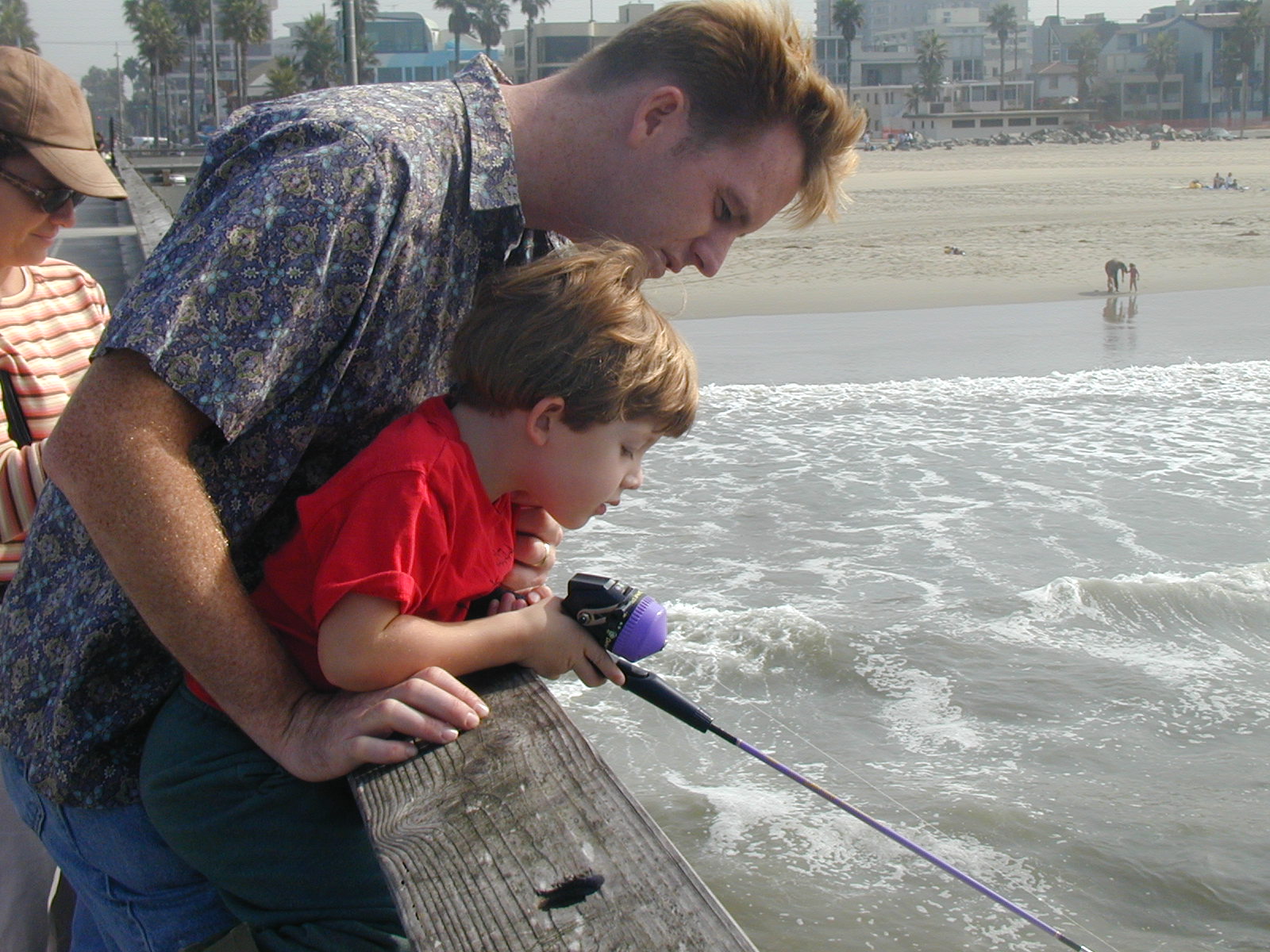
Tom and son
Lo and behold, it didn’t take long, and little Tommy connected with his first fish ever… a 4″ smelt. Tommy was extremely happy, even though we forgot to warn him that the fish sometimes die. He wasn’t too happy about that part. He got over it though, and the last I saw, he was walking back to the minivan with Mr. smelt snugly bouncing in a little Ziploc bag.
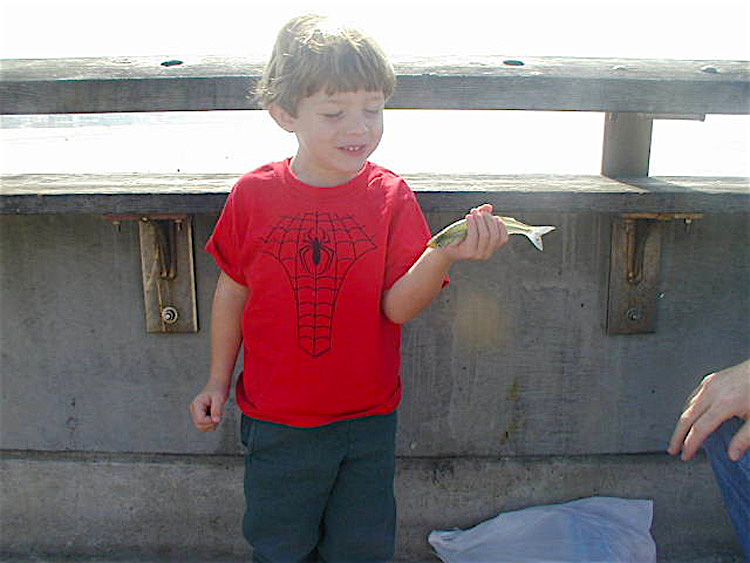
Oh yeah, I caught two more smelt, one about 12″, and one about 6″.
Date: November 17, 2004; To: PFIC Message Board; From: h2o; Subject: Venice Pier 11-15-04
I took a bike stroll on the stretch of beach on Saturday afternoon. Stopped by almost all the piers along the way. Didn’t see anyone catch anything worthwhile, beside Venice Pier. There were lots of bonitos, mackerel and sardines in everyone’s buckets and bags. The pier was packed with fishermen!
I haven’t caught a bonito from a pier before, so I decided to give Monday morning a try. This way, I wasn’t elbow to elbow with everyone and have some quite time to myself. Got to the pier at 5:30am Monday morning and found the gate closed. I had to wait to 6am for the parking lot to open. It only cost 3 bucks to park? I was amazed! This is 2004 right? I haven’t paid $3 for parking in quite awhile.
It was a pretty chilly morning and made my way to the end of the pier. I stopped near the end where all the sardines and smelt were schooling and tried to make some bait. I brought two buckets, one with an aerator built in and one plain Home Depot one. I tied a rope to the home depot bucket, but found out the rope was too short. I didn’t know what to do next so I filled the aerator bucket from the fishing cleaning station with water. I was hoping it was saltwater, but it wasn’t. There was big school of bait, but I only managed to catch 2 smelt. On Saturday, everyone was catching the sardines by the bucket full. After more than half an hour of trying I decided to just use the two smelt for the time being. On my first catch I managed to get picked up, but I missed him. I used my second smelt and got picked up again, but missed again. That was it for my bait.
Some other fellow fishermen came and were catching the sardines and landed a few nice size bonitos. I was about to give up on the bait approach and just use some lures when a very nice person named Harold joined me. He gave some advice on how to catch the sardines. He told me to not use bait (I was using small pieces of squid with my Sabiki) and jig my Sabiki up and down and what you know, I have sardines!
I let Harold use my bait rod and he caught us bait in a matter of minutes. I offered to let him use of my aerator bucket in exchange. On my first fly-lined sardine, I managed a nice size bonito. After that I was landing the bonito like a pro. I definitely had the hot stick. I landed me double digits in just 3 hours of fishing. I could even see my bait being attacked and desperately trying to evade the little tunas. Harold and I managed a limit of bonito. He only caught one because he was too busy making bait. The bit shut off at around 10am and that is when I decided to call it quits.
Had a great time out there. I still would have enjoyed it even if I didn’t catch anything. Met some nice people and got to pull on some fish. It was a beautiful day. Rod Used: Shimano Calcutta Conquest 400 w/ 12lb test and a 9′ Calcutta rod, Shimano Stella AR2000 w/ 6lb test and a 7’6 Fenwick rod.
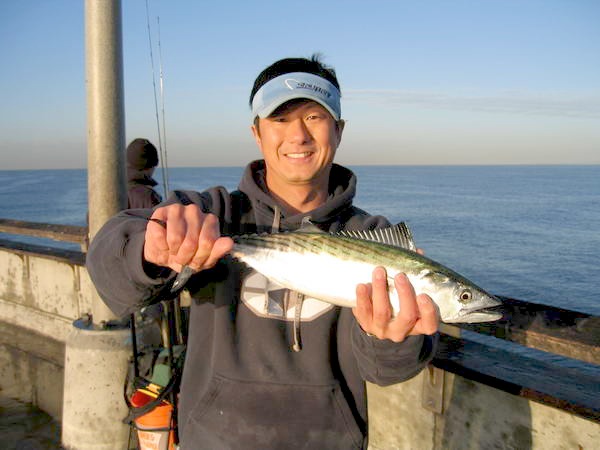
Bonito
Date: July 18, 2005; To: PFIC Message Board; From: grammar police; Subject: 7/17 Venice Pier
The Long: After a long night of booze, dancing, family fun and only 3 hours of sleep, my brother and I headed out to Venice Pier. Picked up some Lug Worms, Squid (for the Rays), and frozen ‘chovies and set up shop by 7am. Was a slow day, the first 3 hours only things caught were small jigged up fish (White Perch, Smelt, Herring, Mackerel). Bait-tipped Sabikis worked OK, and most herring (Queenfish) seemed to be snagged vs. taking the bait. All too large IMO for live bait.
Later we moved from the end of the pier to the surf area/base of the pier. Must have been a nice sand bar built up near the pier. It was no more than 5′ in most spots and this is past the first roller. At the foot of the pier, this old gentleman and what looked like his handicapped grandson, maybe son were nailing the yellowfin croakers and corbina while trying to hook a surfer. Speaking of the surfers, I was yelled at for casting next to them with the Abu C3. I was launching 2-oz like a pro and getting awfully close to them. But in turn, the other side of the pier, surfers were asking us to pull our line in so they could come within 25′ of the pier to catch a wave. I bit my tongue and ignored them. Even though my brother was taunting me itching for a fight… Back to fishing. We caught two corbina (~12”) and one croaker (~11”) that we gave to the couple on the opposite rail.
It was funny the handicapped kid (maybe young adult) was having such a blast. His fishing mojo was really with him. He couldn’t keep either of his three poles in the water. Bait, cast, fish on… His eyes lit up every time he’d start to reel. Grandpa sat close by and supervised him and gave a few pointers. I saw him land a 6” “dinner fish” as he would call them coming over the rail!
A little later a Hispanic lady was creeped out by the baby bat ray on her line. After getting the ~12” WS ray over the rail and hook removed, she started asking if anyone wanted it. I informed her they are live born with about 12” wingspan and he was probably a newborn yielding almost no meat. She asked if I would throw it back for her. Pay-it-forward if you will, I gave a quick class on proper handling (lipping) of bat rays and let her hold it for a quick photo op. After a gentleman passing by gave it a shot, I smiled at the baby and returned him to his home.
Then overcast skies burnt off around 11:30 and by noon we called it quits. I still had to drive an hour to see grandma and pick up rods, then drive home to the Bay area.
The Short: 2 rods: —7′ Rainshadow GDude special Abu c3 laced with 20# mono rigged with surf leader (hi/lo) #6 bait holder hooks with lug worms. – 10′ Sealine Okuma CD90 30# mono with hi/lo and mixed bait ‘chovie and lug worms. Overcast skies, warm air temperature with no red tide in sight. Fished from 7am-noon: (‘Chovies, squid, lug worms (Look like pile worms from our area)) Chris — 1 Big Eye perch, 1 Corbina, 1 Smelt; Me — 2 Herring, 2 YF Croaker, 1 Smelt, 1 (Unknown) Perch — Joey3
Date: December 21, 2005; To: PFIC Message Board; From: gordo grande; Subject: Part of Venice Pier is gone
You can’t pee in the bathroom at the end of Venice Pier anymore. It’s gone! Our chopper at Channel 7 was flying overhead, and there is no trace of what used to be the bathrooms…. just an empty space where they used to be. I’m sure the pier is going to be closed for sometime while they check it for structural damage. Sadly, the pier has only been open for three or four years. Prior to that, I think it was closed for over a decade. Half of the beach north of the pier seems to be gone too… I bet there are going to be a lot more holes and troughs. Up until now I considered Venice to be one of the flatter beaches around… not anymore.
Date: May 25, 2006; To: PFIC Message Board; From: gordo grande; Subject: VENICE PIER IS OPEN!
VENICE PIER REOPENED TONIGHT! Watch the 6pm News on Channel 7. It’s scheduled to be our last story.
Date: June 4, 2006; To: PFIC Message Board; From: toejamb; Subject: Venice Pier
With Hermosa being closed ’til the 12th, I took a little detour out to Venice Pier. I haven’t fished this particular pier for darn near 8 years and it took me a little while to get properly situated and get started in earnest. Made bait pretty quickly, (queenfish, smelt and 7-11s) and got to work. The 7-11s and smelt went untouched, but once I switched over to the queenfish, I saw some action. I had 3 halibut, all shorts, in the span of about an hour and a half. No exact measurements, just wanted to get the critters back in to the water as quickly as possible, although by eyeballing it, I’d say the biggest of the 3 was close to 20 inches. That was pretty much it for me. As for the rest of the pier, I saw the usual mackerel, big smelt, perch etc. “Mr. Happy” was at the pier as well and he landed a 6′ thresher and several shovelnose. It was a nice little excursion to a pier I don’t usually fish, but if you’ll pardon the expression, “there’s no place like Hermosa.”
Date: September 1, 2006; To: PFIC Message Board; From: Mahigeer; Subject: Stop the world, Mahigeer has caught BONITOS
Short version: caught three (3) 12-14” BONITO. The curse is over.
Long version; Went to the Venice Pier tonight around 6:30PM. As soon as I got there, someone was bringing up a 12” Bonito. I hurried to get setup. I had a homemade Sabiki with yellow and green feathers. Wouldn‘t you know it the darn think was all tangled up. It’s like some of those anxiety dreams I have had in the past. So finally I get it halfway fixed and toss it in the drink. A few casts later and every angler’s delight move happens. The line has its own life. It goes left, it goes right. The shimmering belly of the catch which is now swimming sideways makes you smile with joy. I landed the fish and ladies and gentleman it is a BONITO. Yuppie ya yey. The curse is over; the monkey is off the back, no more “Bonita Blues” for me, etc. etc. etc.
Life is good. I have the right rig, the fish is cooperating; all I need to make it better is to have some Pier Rats to share the moment with. But noooooooooo, few casts later and the homemade Sabiki gets stuck. Is it a lot of fish or some obstacle? I will never know. As I pull on the line, snap, the line breaks. There goes the homemade rig.
Next I tie a Blue Fox in Mackerel color (the one on which I landed many Macs. in Redondo after the Contractors show a while back) to a golf ball rig. I got some flashes but noting stuck. Then I switched to a green short Mega Bait. That one landed me two (2) more nice Bonies. I probably would have caught more but I think in order to make splash I was probably retrieving too fast. I would cast out far but most of the action seemed to be close to the pier. The fish would turn and go belly up and turn but it would miss the lure.
There is no comparison between excitement of lure fishing, and actually seeing your lure being chased by a predator; and the boredom of bait chucking and waiting for the fish to commit suicide. So tomorrow, I will be having BBQ Bonito for lunch and will raise a few in honor of the prey who gave its life to provide joy to this old Mahigeer (Angler in Farsi). Happy Labor Day everyone.
Date: July 24, 2007; To: PFIC Message Board; From: Mahigeer; Subject: Venice Pier
Went to the Venice pier tonight for three hours. Top of the high tide, but still a slow bite. Not much being pulled with the exception of one giant sea bass, which was properly released. One horn shark was also pulled up. There was a family where the father was new to hoop netting but he had great luck. He pulled up one 3-lb bug plus several spider crabs… For me the count was one queenfish with the Buzz Bomb and one lizardfish with the bait. That’s all folks.
Potpourri— Perhaps more than you want to know about the Venice Pier
<*}}}}}}}}}>< — I received an interesting e-mail message one day from famed fishing writer Steve Carson. The note was in response to a discussion on the Pier Fishing In California message board concerning favorite bands of the members.
Date: December 15, 2002; To: PFIC Message Board; From: Steve Carson; Subject: The Doors and Venice Pier…
According to “The Doors” bio-book “No One Here Get Out Alive,” the historic meeting of acquaintances Jim Morrison and Ray Manzarek, where Morrison recited his poem that became the Doors’ song “Moonlight Drive,” and prompted Manzarek to say “Let’s start a band and make a million bucks,” took place at the foot of Venice Pier in the summer of 1965, shortly after it opened to the fishing public.
[Morrison lived in and around Venice during the time he was in UCLA. For a period of time he was homeless and slept wherever he could find a place to crash. Apparently his favorites included his friend’s couches, their cars—and under the Venice Pier. KJ]
<*}}}}}}}}}>< — Apparently some pier fish wound up at Marineland. Such was the case with this seven-gill shark in 1978. I’m not sure what happened to them when Marineland closed.
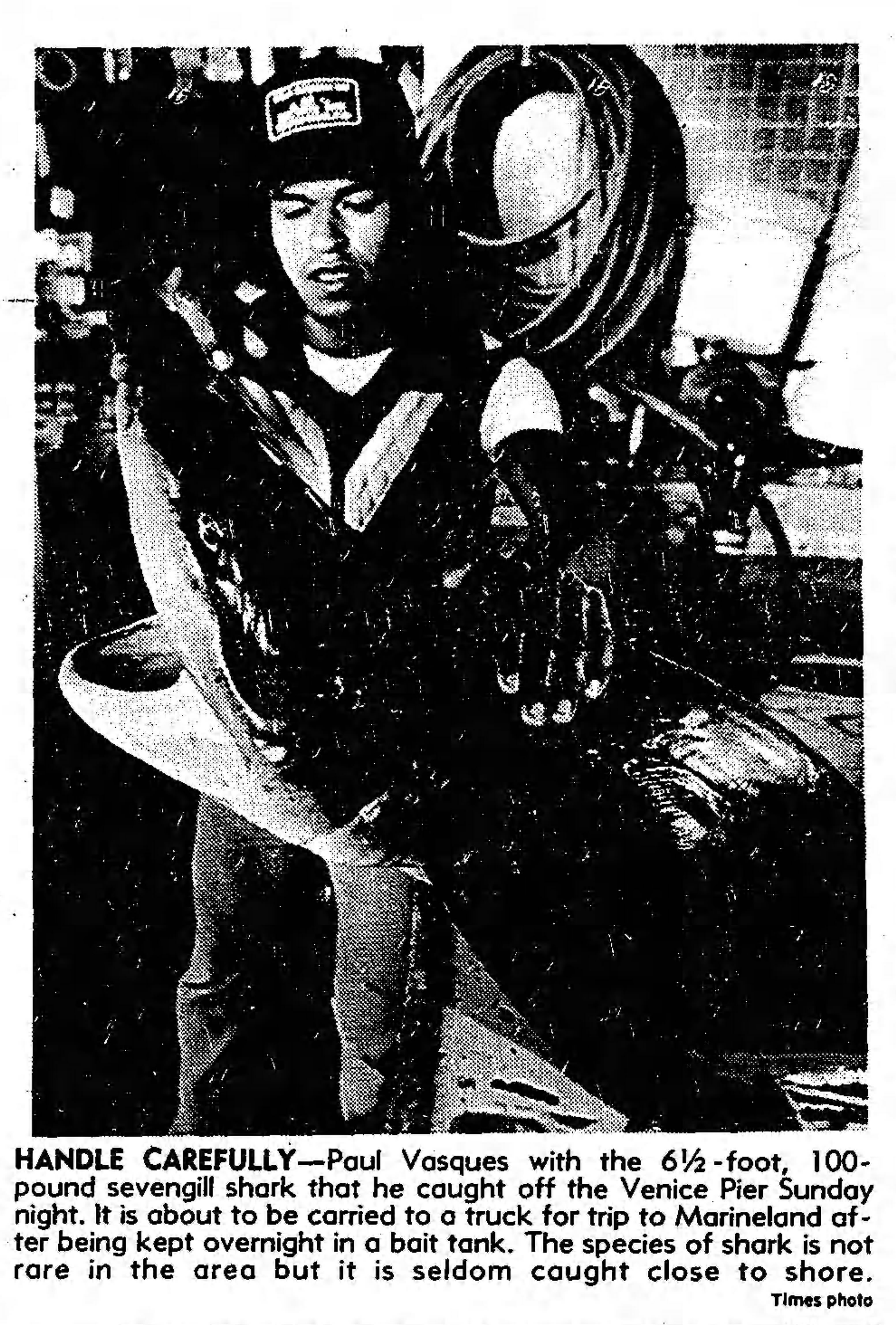
<*}}}}}}}}}>< — Many, many movies have been filmed in Venice and it started over a hundred years ago during the silent film era. The early “Amusement Piers” at Venice (Venice Pier, Lick Pier, Pickering Pier, etc.) were a favorite place for movie scenes and even after most of them closed the area along Ocean Front Walk and Windward Avenue remained popular for movies.
Perhaps to be expected, the Venice Fishing Pier became included as a site for filmmakers. The pier has been featured in several movies including Irreversible (1973); Point Blank (1991); Falling Down (1993); Uh Oh! (2003); Bounce; Lovely and Amazing; Just Married; Local Boys; Don’t; and A-Team (TV).
The only one of these cinematic masterpieces that I’ve seen is Falling Down. Toward the end of the movie, policeman Robert Duvall meets up with psychotic defense worker Michael Douglas out at the end of the pier. Duvall nostalgically recalls the fishing at the pier, “You used to be able to fish right here, now you can’t even swim in the water.” Of course it’s not true but it’s an attitude frequently seen in Los Angeles. As for the Douglas, he jumps off the pier and drowns.
<*}}}}}}}}}>< — The “Venice Pier Strut” is the name of a song on the album Pacific Blue by Franke Christopher, formerly of Tangerine Dream.
<*}}}}}}}}}>< — A gnashing of teeth was heard in 2003 when the Los Angeles Business Journal reported that the L.A. City Council had decided to change the name of the Venice Pier to the “Ruth Galanter Pier,” after a long-time, termed-out councilwoman. The news shocked local preservationists. “I mean her (Galanter) no disrespect, but this is just another attempt to gentrify things in Venice,” said Elaine Alexander, past president of the Venice Historical Society. “The name Venice and everything associated with that name needs to be preserved.” The name of the pier wasn’t changed.
<*}}}}}}}}}>< — Somewhat surprisingly given its fairly common, sandy bottom environment, this was one of the region’s best piers during the warm-water, El Niño years in the early ‘80s. Many yellowtail and white seabass were landed and it also yielded relatively uncommon species like triggerfish and needlefish. Most unusual was the small, 6-pound albacore caught off the far end of the pier in April of 1981.
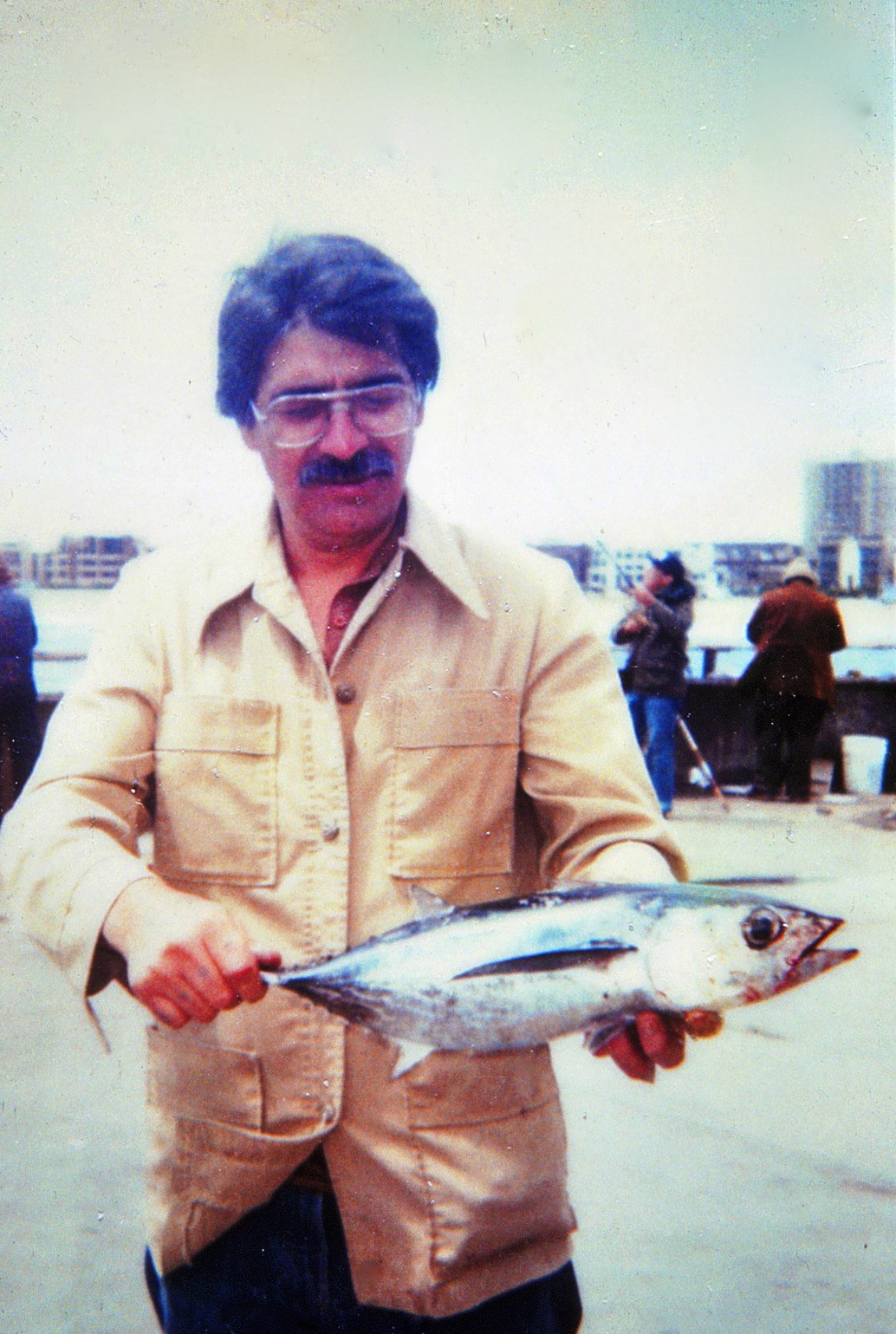
Albacore — caught April 18, 1981
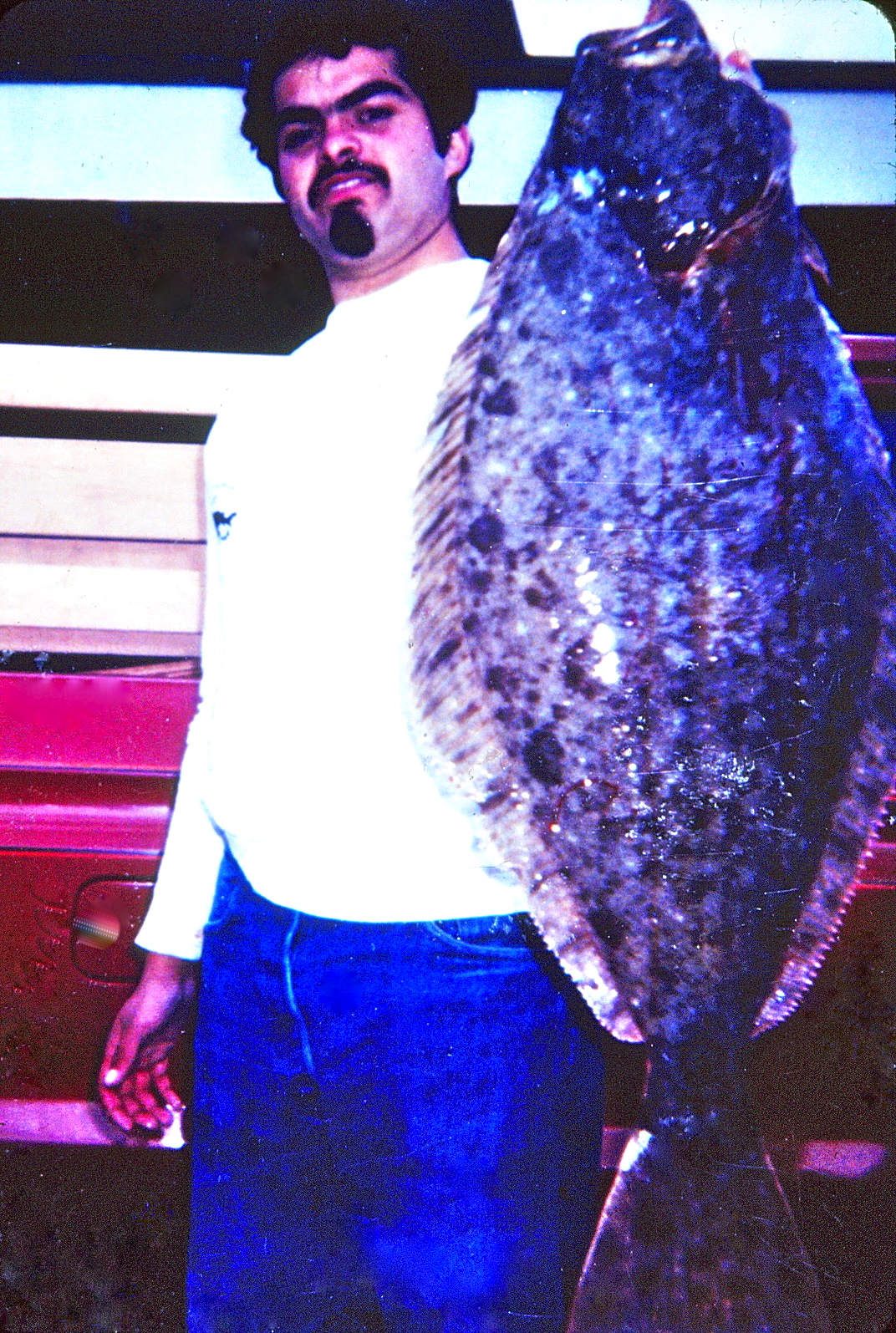
11 3/4-lb. Halibut — caught March 13, 1982
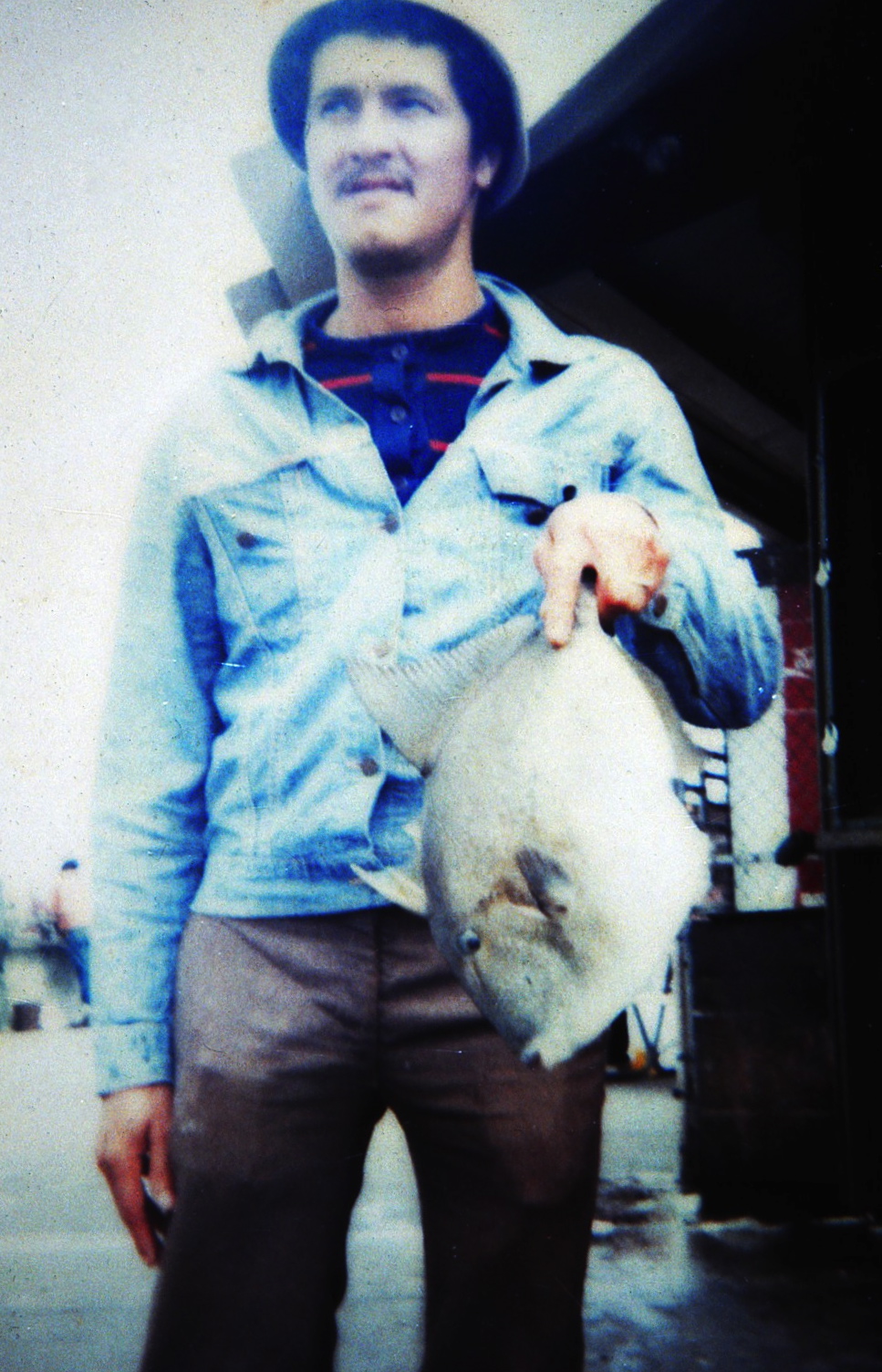
Triggerfish — caught June 20. 1982
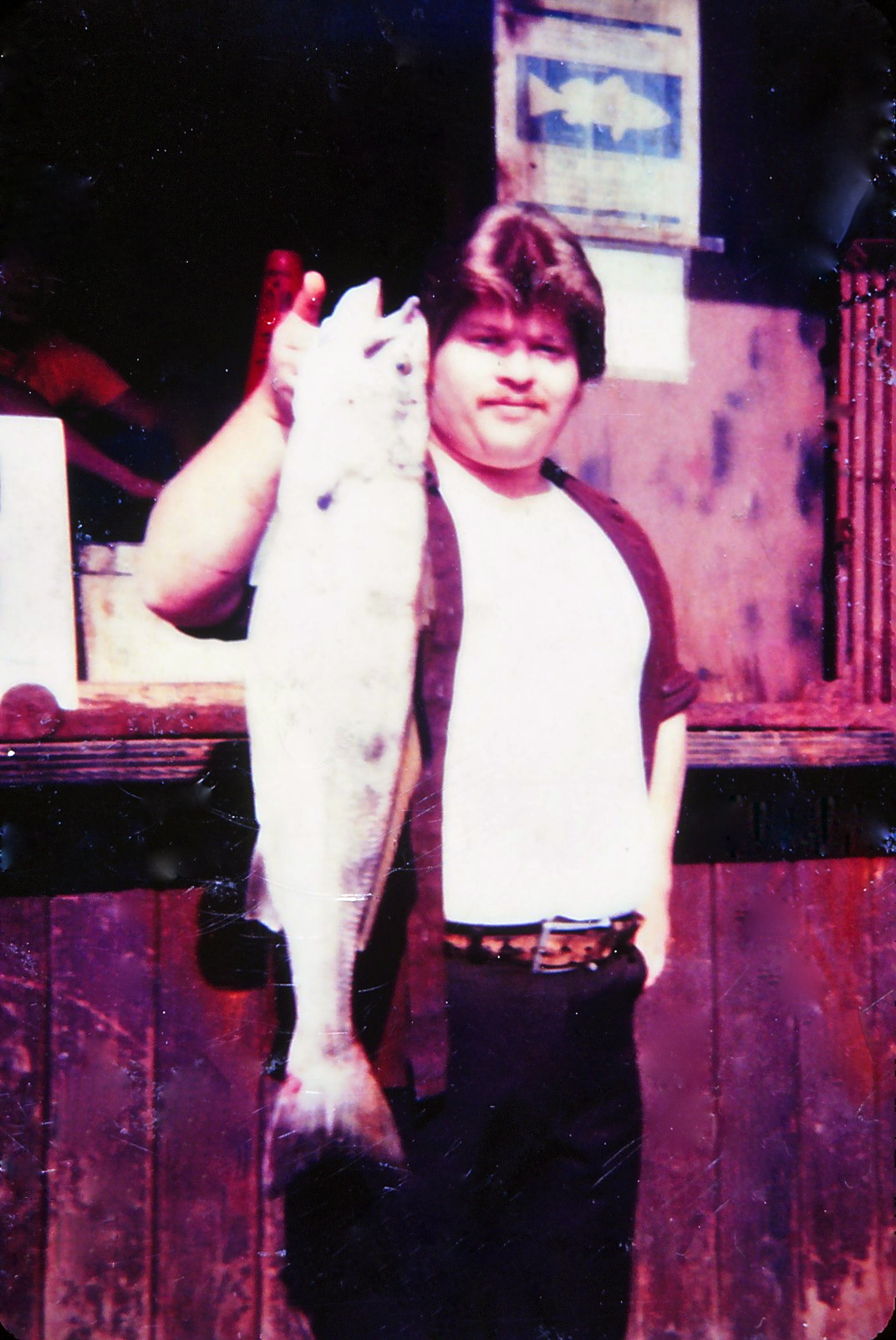
White Seabass
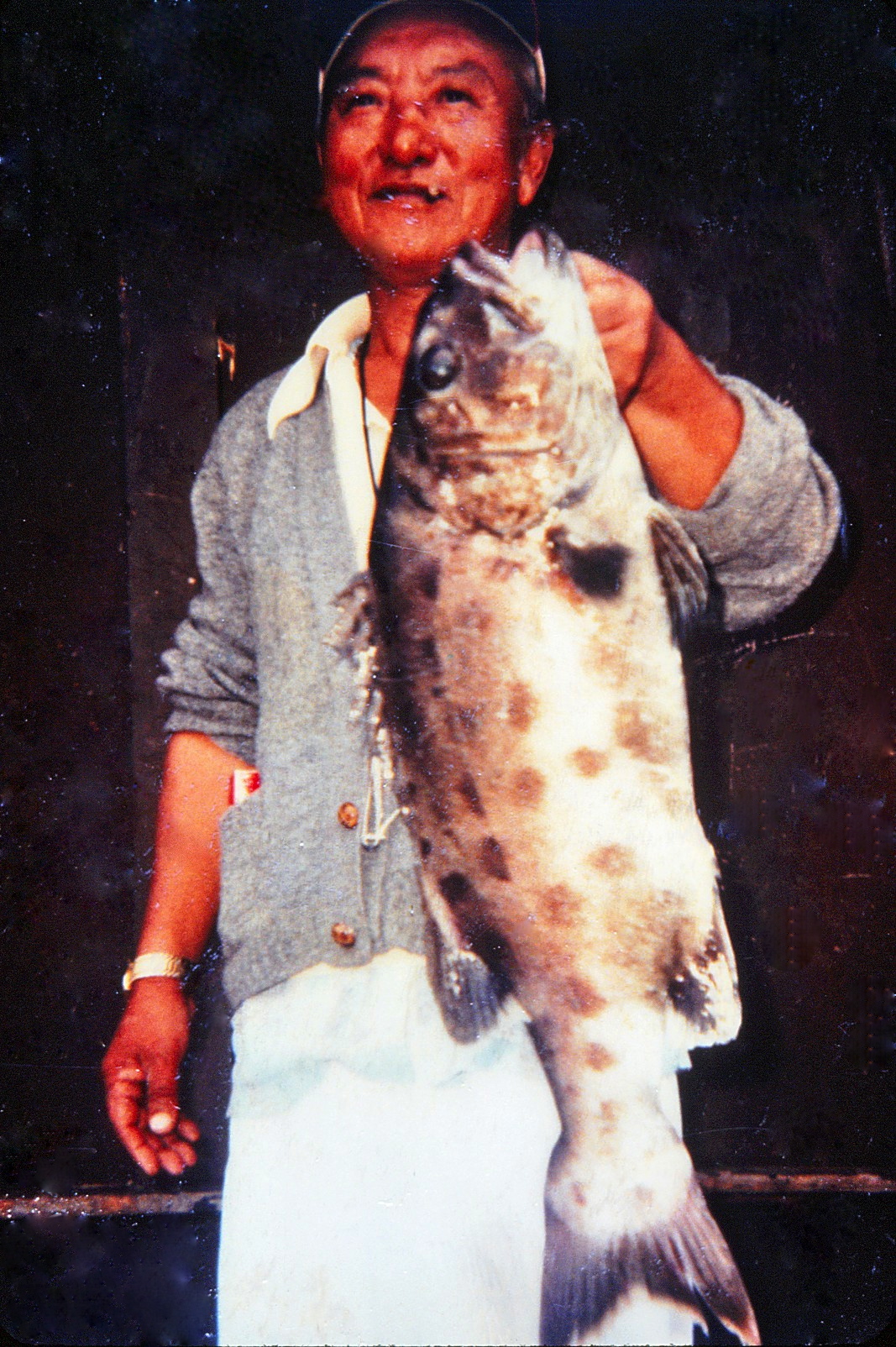
Young Giant (Black) Sea Bass (today this would be illegal)
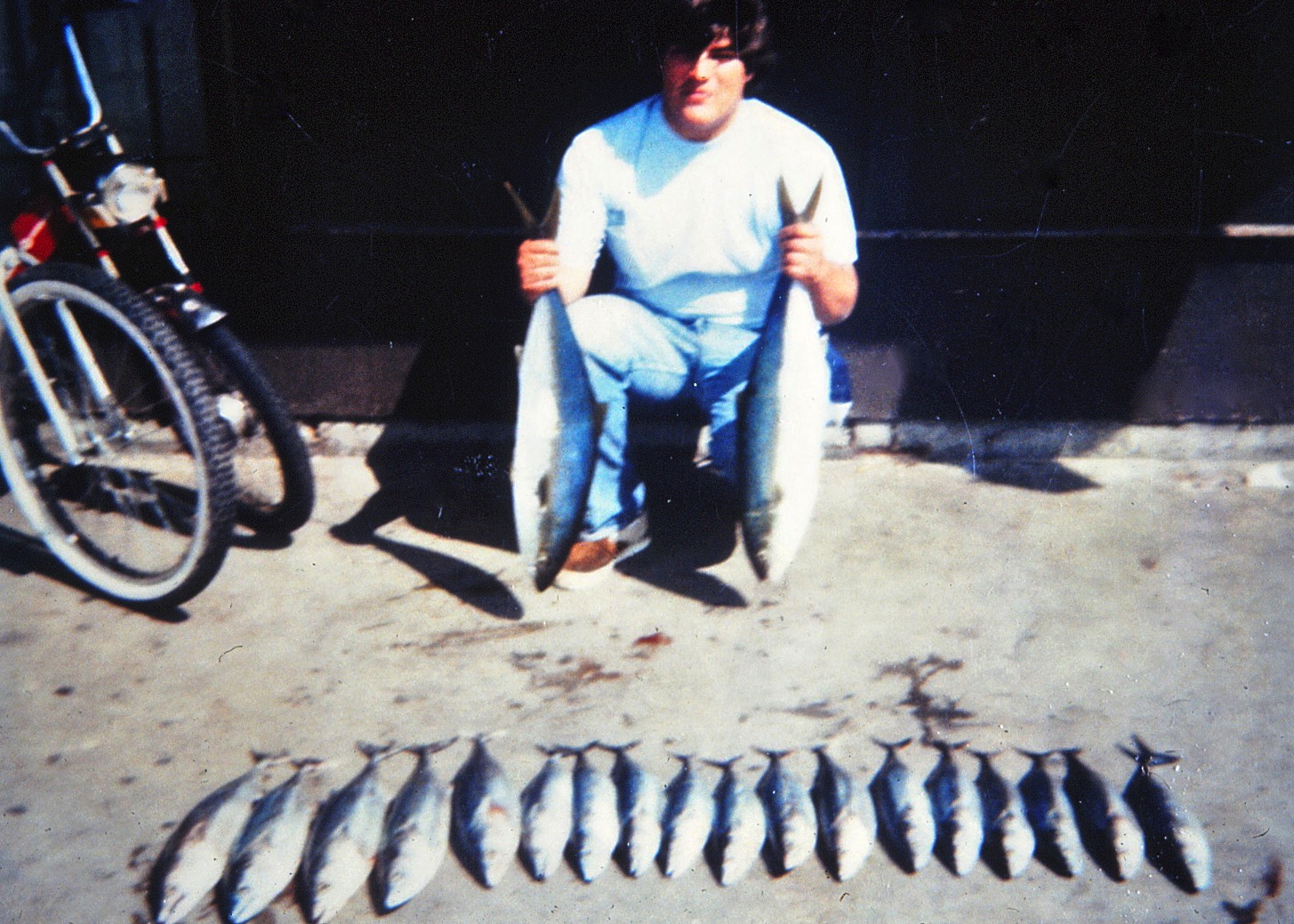
Yellowtail and Bonito
All pictures courtesy of Venice Pier Bait Shop — 1980s
<*}}}}}}}}}>< — Like Berkeley to the north, or perhaps Haight-Ashbury (the Haight) area in San Francisco, Venice has retained its bohemian flavor, a fact that most of the locals cherish. The descriptions of Venice are classic—
Venice is a quiet, shabby little place at the edge of an oil field, which extends for a mile or two along the shore. But you can still see the hotel where Sarah Bernhardt stayed. You can still live at an address on the Grand Canal (though a garbage raft will float past your window instead of a gondola); you can still admire the pure curve of a bridge which would not disgrace Italy, except that it stands among oil derricks, is made of wood and plaster and is apt to fall down soon. —Christopher Isherwood, The Shore, 1952
Venice U.S.A., Venice West, a horizontal, jerry-built slum by blue sea, warm under a semitropical Pacific sun on a Sunday afternoon. —Lawrence Lipton, The Holy Barbarians, 1959
“SoCal’s quintessential bohemian playground is the legacy of Abbot Kinney (1850-1920). A tobacco mogul by trade and a dreamer at heart, Kinney dug canals and turned fetid swampland into a cultural and recreational resort he dubbed ‘Venice of America’. For nearly two decades, crowds thronged to this ‘Coney Island on the Pacific’ to be poled around by imported gondoliers, walk among Renaissance-style arcaded buildings and listen to Benny Goodman tooting his horn in clubs. But time was not kind to Kinney’s vision.
Most of the canals were filled and paved over in 1929 and Venice soon plunged into a steep decline until its cheap rents and mellow vibe drew first the beatniks, then hippies in the ‘50s and ‘60s. A few years later, Venice turned ‘Dogtown’ as modern skateboarding hit the big time. These days there are pockets of gentrification, but overall it’s still a low-key enclave with a strong sense of community…Venice Boardwalk—part freak show, a human zoo and a wacky carnival.” —Lonely Planet, 2005
<*}}}}}}}}}>< — Venice also has its local theater and perhaps not surprisingly one play (at least) took place at the Venice Pier.
New Little Theater Performs in Venice
A new repertory company called Reredos resides in a hole in the wall at 1217 Ocean Front Walk, Venice. It is a 65-seat oblong box with an overhanging balcony and a seating area surrounding three-quarters of the stage, all of which former Synanon lawyer John Clampa has singlehandedly designed and appointed for his own plays.
The theater’s inaugural effort, a philosophical play about today entitled “High Masque,” concerns five lost souls taking long walks on the Venice pier and a bearded prophet in a black turtleneck shirt who sermonizes and poetizes and somehow rejuvenates them…A walking Synanon, he tells three speed-munching belligerents about the momentary heaven of the high and the everlasting hell which follows…
—Los Angeles Times, February 1, 1969
I’m old enough to remember Synanon and the craziness of those years. Synanon started as a drug rehabilitation program in 1958, devolved into the Church of Synanon in the 1970s (just after this play), and became yet one more violent California cult. It disbanded in 1991 due to criminal activities (including attempted murder). Given all that I can’t say I mind missing that play — even if it did take place on the Venice Pier. I think I will just stick to fishing.
<*}}}}}}}}}>< — In late 2004 I received a call from a writer in Field and Stream who had seen Pier Fishing In California and was interested in writing a story about piers, specifically about characters at the piers. What piers would be the best to visit in Los Angeles? Of course Venice and Santa Monica were two of my initial suggestions. After several phone conversations and email messages he felt he was ready to tackle LA. A few months later the following emerged:
Fishing the Venice Beach Pier — On this narrow strip of concrete in West L.A., the exotic fish of the Pacific meet the funky anglers of Southern California.If you visit Venice Beach and its carnivalesque boardwalk, your eyes will swim in a vast sea of human oddities. Walking past the tattoo parlors and incense vendors and T-shirt shops, you will dodge bikini-clad inline skaters, beer-soaked collegiate tourists, hustlers, chain-saw jugglers, mimes, preening musclemen, break-dancers, sidewalk artists, prophets, snake handlers, conga drummers, Hare Krishnas, junkies, street-corner evangelists, panhandlers, and even a turban-topped, robe-wearing electric guitarist named Harry Perry, the “Kama Kosmick Krusader,” who’s spent the last 30 years noodling fuzzy solos on his bull’s-eye-painted guitar while skating up and down the Venice boardwalk.
The Dawn Patrol — If you arrive very early in the morning, when the Pacific and the sky are an almost indistinguishable shade of bruised purple and the dark shops along the boardwalk are silent and shuttered, you’ll notice a small cadre of men pushing homemade carts loaded with bait and tackle and plastic-wrapped sandwiches.
In the gloom, they steer their carts to the gate at the Venice Fishing Pier and wait—10, 20 of them, sipping coffee, the orange glow of their cigarettes specking the dark as they wait for the pier guard to drowsily unlock the gates at 6 a.m. These are the fishermen of the Venice Pier, and when the gates open, they stream forward and take their positions along the pier’s 1,310-foot length. Then, the low mumble of the waves is quickly joined by the whir of lines being cast, by the wet plunk of sinkers hitting the water, by the happy reel-screech of a fish on.
Pier of Dreams — If the Venice boardwalk is a human circus, as many observers have described it, then the long, keyhole-shaped pier that abuts it is an angling circus, a narrow strip of concrete where the exotic and unpredictable denizens of the Pacific Ocean—needlefish have been reeled up onto the pier; occasionally someone hooks a sea lion—meet the exotic and unpredictable anglers of Los Angeles.
Piers attract a different sort of fisherman than, say, lake edges, and certainly streamsides—different, that is, though fundamentally the same. For those without the cash or gas or stamina to fish for Castaic Lake largemouths or San Gabriel River rainbows, or to charter a boat and head out to sea, a humble pier can be a thing of beauty. And the fact that no fishing license is required on California piers gilds the lily.
Some anglers revel in the social aspects of the fishing, the easy fellowship of a pier rail. For others, consistency is the draw. “If you have the soul of an artist and can see and feel the rustic charm of old…structures that have long withstood the lash of time and tide,” wrote Raymond Cannon in How to Fish the Pacific Coast in 1953, “you will at once recognize something of the hypnotic spell that compels addicts of pier fishing to return again and again, day after day, to the same old spot. Fish or no fish, rain or shine, you will see them, happy, cheerful, and contented, ensnared in the mesh of a magnetic net of their own mental creation.”
Sympathy From the Devil — That same old spot, for Stephen Penn, is beside a graffiti-coated trash barrel on the left side of the pier end, with a view south toward Marina del Rey. This is where, nearly every morning, Penn plants his folding chair and sets up a medium surf-casting rod, equipped with a secondhand Shakespeare reel, as well as a telescoping baitcaster with a length of 20-pound-test line tied to the last eye. He baits the hooks using mussels or razor clams, casts out toward an artificial quarry-rock reef, settles deep into his chair, and prays that “the devil” won’t leave him fishless that day.
When I met him, the devil hadn’t let him catch a fish all week. “I set my pole up with one hook,” he said, as if asserting the purity of his tactics over those of neighboring anglers throwing a two-hook high-low leader. “One hook, one fish. That’s all I want. Won’t that devil please give me just one fish?” A native of Youngstown, Ohio, where he grew up fishing for walleyes and perch, Penn is a singer and songwriter who once, he claims, wrote a song with funk legend George Clinton.
But Penn fell on hard times, did some literal hard time in prison, and now, homeless, spends the bulk of his days fishing in Venice while composing songs in his head—love songs, mostly, because they make people happy. “It’s kinda hard to get back on your feet,” he says. “But this is good. I get to sit out here every day thinking about lyrics and notations and sometimes I can catch me some fish. Not today, though. I’m just making music today. Rojas, he’s doing all the catching.”
Numero Uno — Rojas is 56-year-old Rogelio Muñoz, a big-shouldered, round-bellied native of Zacatecas, Mexico, who’s lived in L.A. for two decades. Everyone calls him Rojas, and he’s the unofficial boss of the Venice Fishing Pier. On the weekends, he is the first to arrive at the gate. If the guard is a minute late, Rojas bangs on the gate’s bars, and because he is the boss, the gate quickly swings open. Often joined by his three nephews, Rojas lords over the 120-foot-diameter circular end of the pier, with his five rods spread widely along the railing. He is a serious, determined fisherman and is almost always busy: dispensing advice, barking orders, tying leaders for his nephews or for the other Mexican fishermen who bow to his expertise, all the while eyeing his lines with the frowning intensity of a football coach, spitting sunflower seeds to the sea.
He can be magnificently productive. “One day,” a fellow fisherman boasted, “I saw him catch nine sharks.” At times, usually in the afternoons when the action is slow, he naps on the concrete, lying flat on his back; he is almost never disturbed. If he is, it is only because someone has caught a big fish, and the boss likes to inspect any big fish.
When I first encountered him, he was hoisting up a sand shark, snagging it with a heavy treble hook attached to a foot of chain and a length of cotton rope, and raising it past the mussel-encrusted pilings. A crowd gathered around him as he slapped the shark onto the concrete, wrestled it still, and fetched a tape measure from his pocket. “Cuarenta y cuatro,” he announced—44 inches. Onlookers and passing joggers watched with expressions of distaste. The natural world can seem startlingly alien to Los Angelenos.
Once the inevitable photo was snapped, Rojas dragged the shark across the concrete to a shady strip beside the pier rail, where it would remain throughout the long day. One of the curiosities of the Venice Pier is that hardly anyone seems to bring coolers. Fish to be kept are unhooked and then dropped, unceremoniously, on the shadowed concrete beside the rail. You can’t spark a conversation by asking a fisherman about the day’s action; the answer lies gasping at his feet.
“The funny thing about Rojas,” another angler confided to me, “is that he doesn’t even like to eat fish.” Catch-and-release is only rarely practiced in Venice. The Koreans, who congregate mid-pier, carry their fish home to fry with hot pepper threads or to chop into soup; the Russians, who mix—sometimes uncomfortably—with Rojas’ crew at the pier end, salt the sardines they get to be dried on a roof on a hot, sunshiny day; and the Mexicans often cook their catches right on the pier. For those who don’t fish for keeps, or for those whose haul exceeds the limits of their bellies, an old, dumpling-faced Russian woman in a babushka takes up the slack. Every other day or so, at 3 p.m., she wanders from fisherman to fisherman offering $3, and always $3, for a herring, surfperch, or white croaker. Her money is invariably refused by the regulars—even the homeless fishermen wave it away as they hand over one of these—or if she’s lucky, a mackerel or halibut.
The Dark Side — For the most part, the Venice Pier is like that—laid-back, generous, grimy but good-hearted—though sometimes, after dark, and especially when it’s crowded, things are not so mellow. Venice, which closes at midnight, is one of the few L.A. piers that isn’t open 24 hours a day, allegedly due to a not-so-recent shooting in the parking lot. Several years back, up the coast on the Newport Beach Pier, a 60-year-old fisherman tangled lines with an 18-year-old, and when the younger man cut the other’s line, a fight broke out. After some shouting, and after each man had thrown the other’s rod over the pier railing, the older man pulled a knife and started swinging. When the younger man disarmed him and tossed the knife to the sea, the older man grabbed someone else’s fishing rod and started lunging with that. “At some point,” the police later said, “they ran out of weapons.”
Crossed lines can sour the camaraderie in Venice as elsewhere, but ethnic differences can also chafe. One afternoon I watched a Mexican man strike up a conversation with a pair of old Armenians on the subject of tomatoes, which the Armenians were eating like apples. When the old men exchanged words in Armenian, the Mexican narrowed his eyes, huffed, and said, “I don’t know what you said but it was about me so I’m gonna walk away.” The old men shrugged lazily to one another and returned to their tomatoes.
Party Time — Differences melt away, however, when the fishing is good—when the devil, as Stephen Penn might put it, is looking the other way. “In the busy time,” a fisherman named John Halimi told me, “you’ll see 10 fish coming up per minute.” Another Venice angler put it this way: “Sometimes it’s like flipping a switch. And then—then it’s a party.” Passing schools of bonito can flip that switch, and when they show up, the Venice Pier all but explodes. So too with mackerel—a “mac attack,” not an uncommon experience, is the stuff of pier fishermen’s dreams. Halibut, however, are by far the most prized fish here, and a number of fishermen focus solely on them, slowly dragging a live anchovy along the bottom and waiting for the halibut’s soft-mouthed strike—hoping like hell they’ll nab a “barn door,” slang for an ultrarare (around piers, anyway) jumbo halibut clocking in at 30-plus pounds.
Ken Jones, in his encyclopedic-and-then-some guidebook, Pier Fishing in California, determined that the all-time California pier-fishing record belongs to a man named R.A. Hendricks, who caught a 453-pound black sea bass from Stearns Wharf in Santa Barbara in 1925. After a two-hour battle, Hendricks leaped into a rowboat alongside the wharf and dispatched the mammoth fish with a .22 rifle. A sepia-colored rumor has it that a 600-pound sea bass was caught in 1929 at the Manhattan Beach Pier, a few miles south of Venice, but Jones has never been able to verify it. “The old-timers say it used to be like that,” an angler named Greg Wolthausen told me. “They say there used to be so many fish here that if you jumped off the pier you’d break your neck on them.”
Talk like that—about old-timers, legendary fish, the theory and practice of using a Lucky Lura for jack mackerel, etc.—can almost make you forget where you’re standing. A brief glance behind you, however, and you’re instantly reminded: This is L.A., baby. The beaches are thronged with sunbathers, and aspiring starlets brown themselves in the sun.
Yet life on the pier seems removed from all that, as if L.A. stops at the water’s edge and another, truer world begins. It’s a world familiar to anyone who fishes, and while the fishermen of the Venice Pier may differ from their counterparts on, say, a trout stream, or their more ambitious brethren out trolling in the blue water, they sound much the same when they talk about their fishing. “You know,” John Halimi told me, as he punctured a sardine with a No. 2 hook and then cast it out toward the horizon, “I can either stay home and watch TV, or I can come out here. And when I come out here, whether I catch a big fish or a little fish or no fish at all, I feel the same. I feel better.”
—Jonathan Miles, Field & Stream, May 2005
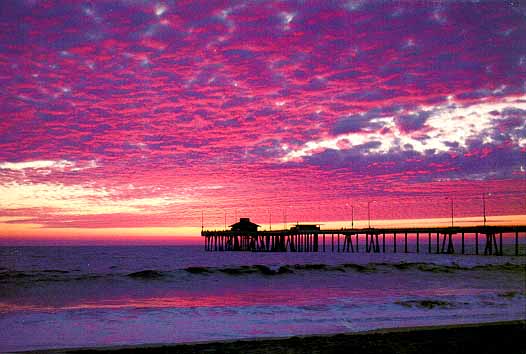
History Note. Although the most famous pier in Venice was Abbot Kinney’s original Venice Pleasure Pier, the life of that pier ended in 1946. That pier and the other pleasure piers that had made Venice and Ocean Park the Coney Island of the West were all at an end by the mid 60s. The result was a change to the area, some saying for the better, some saying for the worse. There was no disagreement on the issue of fishing since the previous piers had provided recreation access that was no longer available.
Eventually sentiment and consensus for a fishing pier emerged and luckily it coincided with conditions in Sacramento conducive for a pier. The Wildlife Conservation Board’s program for piers had begun in 1959 and by 1963 money to build or reconstruct nine piers had occurred. The Venice fishing pier would be next.
The new pier would cost approximately $890,000 and be financed jointly by the California Wildlife Conservation Board and the Los Angeles City Recreation Department.
In March of 1964 construction began on the new pier and less than a year later the new Venice Fishing Pier emerged. The grand opening was on Saturday, February 27, 1965 and dignitaries included California Gov. Edmund G. Brown, Los Angeles Mayor Sam Yorty, members of the Wildlife Conservation Board, and assorted other county and city officials. The Venice High School orchestra provided music and everyone reported having a good time.
The pier itself was built entirely of concrete and reached 1,310 feet out into the Pacific where it ended with a circular end 120 feet in diameter. It was 16 feet wide and came equipped with individual fishing stations that extended out from each side of the pier at 84-foot intervals. Each station contained benches and lights and the pier included a fish-cleaning platform and restrooms. Apparently the pier was popular as an estimated 10,000 anglers used the pier that weekend. The pier quickly became a destination for local anglers and most days would see anglers happily heading out to the pier; life was good.
However, the good life would change in the early 80s when Venice became yet another of the piers that were damaged by ferocious El Niño storms. In 1985 the pier was closed and remained closed for more than a decade. Although Los Angeles officials had originally predicted that it could be reopened by 1993, they were wrong! And though money was finally funded to repair the damage it was found that the structure itself was unsafe. The following story describes the situation well:
Tide Running Against Old Venice Pier
Plain as a hunk of concrete can be, the Venice Pier has always lacked the flair of its wooden, turn-of-the-century predecessor, which offered such eye-catchers as the Giant Dipper Roller Coaster, the Bamboo Dragon Slide and the galleon-shaped Ship Cafe. Didn’t actress Sarah Bernhardt once personally compliment the Ship’s chef on his ragout of spring lamb? The Divine Sarah would have been hard-pressed to find that dish at the modern-day pier’s hamburger stand.
In fact, before the 1,200-foot-long structure was closed for safety reasons 15 months ago, its biggest attractions were a video arcade and a couple of pay telescopes—much to the surprise of tourists expecting a taste of offbeat Venice. “They’d come out here and think they were going to see the guy juggling chain saws or something,” recalled lifeguard Jon Moryl. “They didn’t realize this was another side of Venice.”
What this side was, in the words of resident Frank Maddocks, was a “place where a family could bring the kids out, catch some fish and spend the whole day. It was a place where senior citizens could chat and look at the view.”
No more. Closed after the discovery that chipping concrete was falling from its base, the 23-year-old fishing pier has been targeted for demolition by the city Department of Recreation and Parks.
Maddocks heads a group—Pier Pressure—trying to save the spot. The county Department of Beaches and Harbors, which formerly operated the pier, turned it back to the city last October because, spokesman Larry Charness said, “The revenues were minimal and the liabilities tremendous.” One daunting factor was the $3.26-million settlement paid by the county last year to a jogger struck and paralyzed by a 150-pound chunk of concrete that fell from the 68-year-old Manhattan Beach Pier. While the cracked portions of the structure had to be wrapped in chain-link fencing and adjacent stretches of sand were fenced off, the Manhattan Beach Pier remains open.
The Venice Pier was similarly wrapped, but Joel Breitbart of Recreation and Parks said engineers have concluded that “nothing we can do would make it structurally sound, regardless of how much money we spent.” Demolition doesn’t come cheap. It’s listed as a $500,000 item in the department’s capital improvements budget proposal.
Ironically, last month’s storm, which damaged the Huntington Beach and Redondo Beach piers, hardly mussed up the Venice Pier, located off Washington Boulevard. “If it’s condemnable after surviving that storm, everything along the coast is condemnable,” said Mike Ballard, whose family ran a bait shop at the seaward end of the pier for 20 years. Ballard calls the Venice Pier, with conscious irony, “The Pier That’s Still Standing.”
How could the 23-year-old structure fall into such disrepair while 60- and 70-year-old counterparts up and down the coast survive? That’s the question asked by Jack Leighton, an investment management consultant who misses taking walks over the water. “There ought to be some sort of committee to investigate what went wrong,” he said, “and I’d like to be a part of it.”
Attempts to reach the pier’s designer, Daniel, Mann, Johnson and Mendenhall, a Los Angeles-based architectural and engineering firm, over the last week were not successful. However, Breitbart of Recreation and Parks says comparisons of piers are meaningless because the surf and climatic “conditions are different for each.” The Venice Pier’s problems stem from water that seeped through its concrete, rusting the steel reinforcing bars inside and causing them to expand and pop out pieces of concrete.
Nevertheless, Ted Anvick, a structural engineer who is helping renovate the 77-year-old Santa Monica Pier, believes its Venice neighbor could be reinforced and strengthened too. “There are techniques to prevent (concrete) corrosion,” he explained. “We know that the reinforcing steel can be coated with epoxy or galvanized (coated with zinc).”
Cathy Connelly, a public relations woman working without charge for Pier Pressure, was encouraged by Anvick’s appraisal. She suggested renovating the pier, perhaps with the help of sponsors, a not unprecedented arrangement at the beach. County lifeguards drive trucks that bear the logo, “Nissan, Official Truck, Los Angeles County Beaches.”
Pier Pressure’s strategy is to work with City Councilwoman Ruth Galanter, generate support with petition drives, and raise funds through the sale of T-shirts with a pier logo designed by cartoonist Ron Overmeyer. “We’re still trying to determine what the people want,” Galanter spokesman Rick Ruiz said cautiously. (Recreation and Parks’ demolition request requires approval from the City Council and Mayor Tom Bradley.) Local merchants are divided because the fishermen aren’t viewed as big spenders. Some residents complain about parking problems.
—Steve Harvey, Los Angeles Times, February 5, 1988
The need for community support—and agreement—would be a key.
Venice Pier’s Future Lies in Hands of Residents
The deteriorating Venice Pier, scheduled for demolition, will get a reprieve while the city attempts to determine whether there is community support to repair or replace the structure,according to Joel Breitbart of the Los Angeles Recreation and Parks Department.
The state Coastal Conservancy, which funds restoration of coastal recreation facilities and wildlife habitats, recently offered to pay half of the $100,000 cost for a study on saving the pier, which has been closed for nearly two years.
Although the parks department has received $500,000 in its new budget to demolish the pier, Breitbart said the city will not raze the structure until the conservancy has conducted a public meeting on the pier’s future. The meeting will be held sometime this year.
The 1,200-foot-long concrete pier was closed in November, 1986, after pieces of concrete fell off. County officials who were then managing the pier discovered that the steel frame of the pier deck was corroding. They determined that the pier could not be saved and that the $4.5 million needed to replace it was too much.
If the public meeting determines that there is support for the pier’s repair or replacement, Breitbart said it would be worthwhile for the city to match the conservancy’s $50,000 offer to pay for the study. If the study finds that the base of the pier is still intact, it may be possible to replace the damaged concrete deck for less than it would cost to build a new pier, Breitbart said.
But he emphasized that the city will not commit itself to helping to pay for the study until it can determine whether the community is interested. “We feel the first question that has to be answered is: Does the community still think the pier is something worth keeping?” Breitbart said. “If yes . . . should it be the same length, should it be the same width, should there be any kind of commercial establishment on the pier?”
So far, Breitbart said, the only contact from the community has come from members of Pier Pressure, a small group of Venice business people and residents who are trying to rally support for saving the 24-year-old structure. The group hopes to raise $16,000 to pay for a survey that will be mailed to 30,000 Venice residents, said spokeswoman Cathy Connelly.
Los Angeles Councilwoman Ruth Galanter, who represents Venice, is also waiting to hear from residents before she takes a position, said her deputy, Rick Ruiz. Galanter “is 100% behind giving the community a chance to have their voice heard on the pier,” Ruiz said.
Lifeguard Jeff White, who watches the empty pier during the day from a small booth at its entrance, said the pier used to attract 500 people a day during the summer. “I can’t tell you how many people a day ask me to let them out on the pier,” he said.
Two former regulars, Julius Polsky and Theodore (Ted) Rubenstein, are buddies who met four years ago on the pier, their favorite fishing spot. “We had a good place here,” Polsky said. Most of the 25 to 100 regulars “got to know each other during the last 10 years. It was a really nice gathering.” The two retired men—Polsky owned a tire store and Rubenstein managed a liquor store—do not consider themselves community activists. But they say that they gathered more than 400 signatures on a petition during a recent 10-day period asking the city of Los Angeles to reopen the pier immediately.
The city is not likely to grant their request. Breitbart said any use of the pier would expose the city to risks.
—Jay Goldman, Los Angeles Times, July 14, 1988
It was a long process but finally in 1993 voters passed a $10,000,000 bond issue to renovate both the pier and the Ocean Front Walk. Reconstruction began in 1996 and included replacement of the decking on the inner 600-foot-section, repair to the outer 600 feet, and replacement of all handrails. Although most pilings were retained, “cathodic protection” was given them to insure longer life. Pier fishing structures were upgraded and ADA compliant fishing stations were added. According to the engineers the estimated life for the renovated pier would be 70 years.
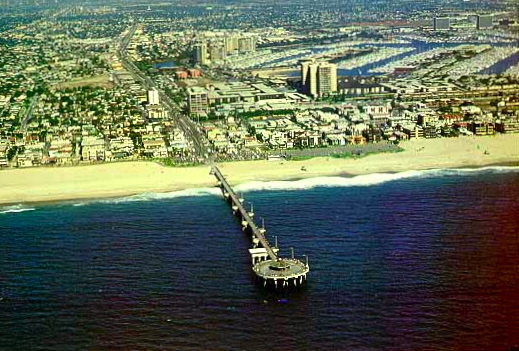
What in many ways was a new pier officially opened in November of 1997 after the $4.5 million restoration. Anglers headed out to the pier and once again life was good. Apparently though anglers had actually begun fishing the pier prior to the grand opening; an article in the Los Angeles Times dated October 23 reported that the fish helped celebrate the opening by “biting like crazy.” That year was a warm-water El Niño year and the same “good fishing” results were true at most SoCal piers.
Of course, life for an oceanfront pier is always risky—and always open to the whims of Mother Nature. Christmas Eve 2005 brought little joy to local pier rats, instead they saw headlines in the Los Angeles Times that reported new damage to the pier.
Deadly High Waves Batter Coast—Venice Pier is closed because of possible damage
Huge waves dragged a concrete public bathroom off the Venice Pier and into the sea amid a week of pounding surf that also beat up on sea life. The restroom, which held the beach’s foghorn, was knocked off its pilings early Wednesday. “Never in my life have I seen waves this big,” said Jon Kirk Mukri, general manager of the Los Angeles Department of Recreation and Parks, which oversees the structure.
The restroom was near the middle of the fishing pier in a section that extends out to the north overlooking Malibu. Workers will probably need to inspect the underwater portion of the damaged pilings, but they may have to wait up to two weeks for the waves to dissipate. The National Weather Service said the high surf, caused by storms about 1,100 miles out in the Pacific, is expected to ebb throughout the weekend before kicking up again next week.
—Hector Becerra and Steve Hymon, Los Angeles Times, December 24, 2005
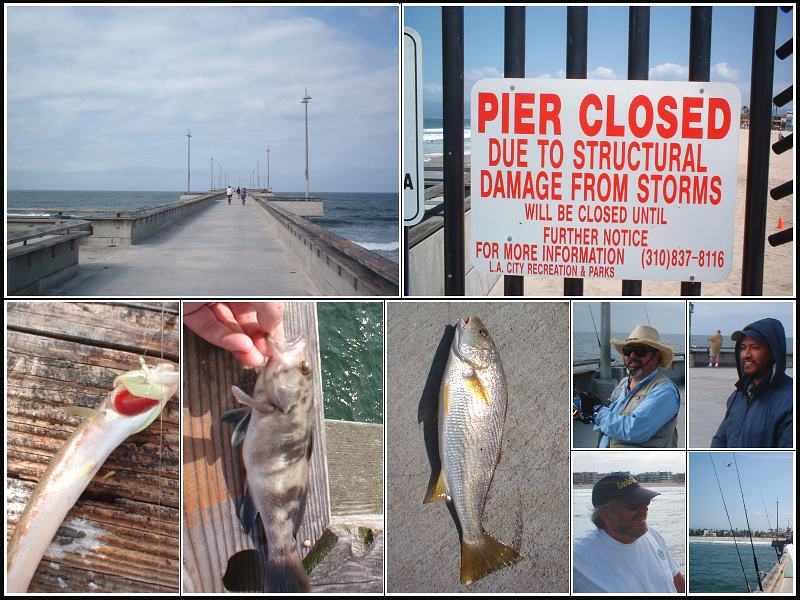
The pier was quickly closed with entry blocked by a chained metal gate. Officials announced they would have to send a group of divers down to see if there was damage to the pilings or if sand had been eroded from the pilings. Initial results sounded gloomy and once again doubts emerged about the future of the pier. Eventually though it was determined that the ocean floor and the sand around the pilings were stable and the pier would be safe to open.
The pier, now minus its restrooms, would reopen six months later on May 25, 2006. In 2008 work took place on the pier once again when most of the wooden railings were replaced. The problem was TERMITE damage, the first time I have heard of that problem on a pier.
Today the local citizens are once again able to stroll the pier, enjoy the ocean breeze, and even fish if that is their pleasure. Life is good.
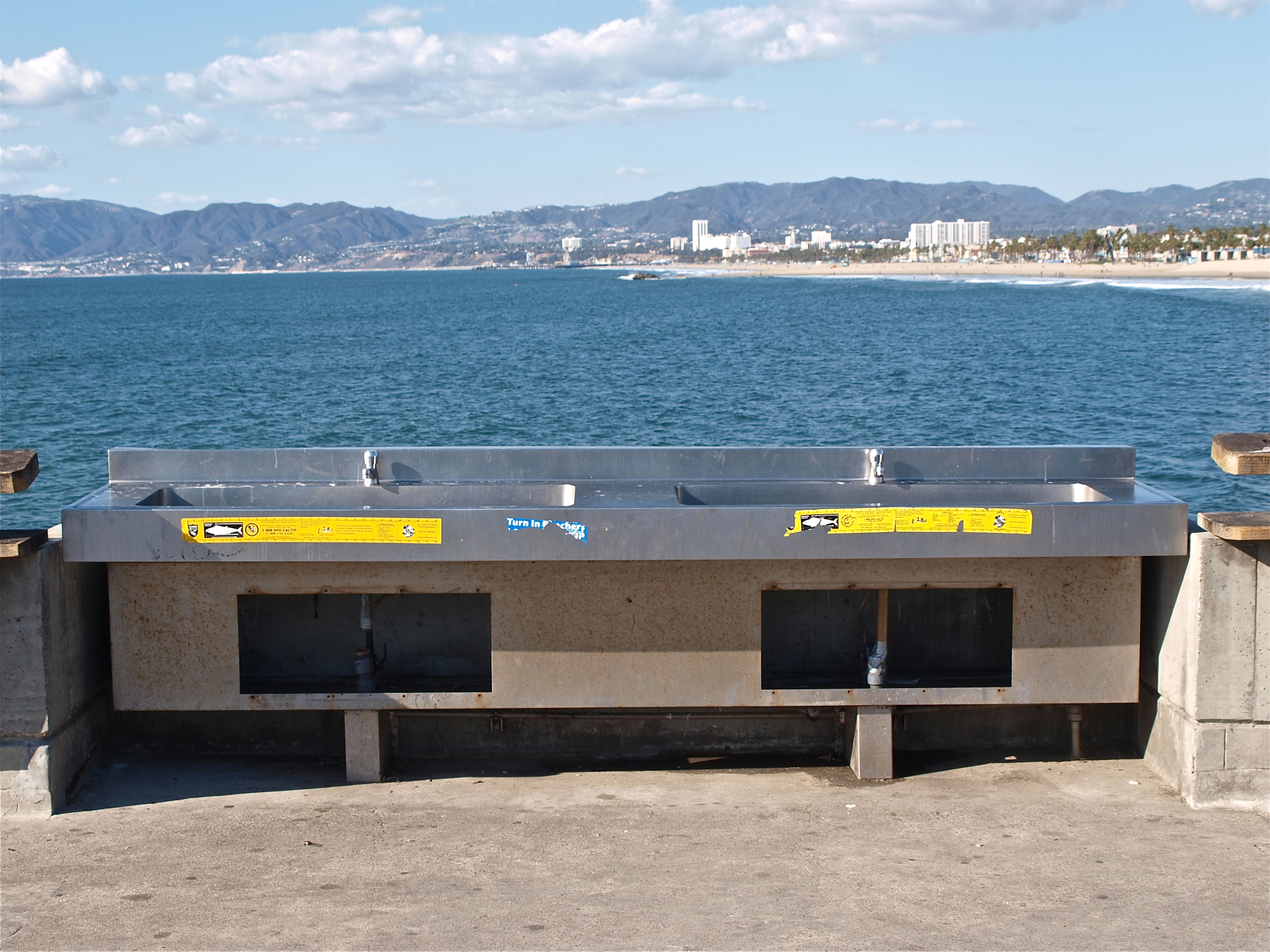
Amenities include a large fish cleaning sink
Venice Fishing Pier Facts
Hours: Open from 6 a.m. to midnight.
Facilities: The pier includes lights, benches, fish-cleaning stations and restrooms at the end of the pier. Parking is available at the foot of the pier for $6 but arrive early if you expect a spot. Weekend days, especially summer and fall, are very, very busy. Some (actually fairly limited) metered parking is available on nearby streets and the city itself heavily promotes taking a shuttle to the beach. Some frozen bait is available just up the street at Nick’s Liquor store.
Handicapped Facilities: Handicapped parking and restrooms. The pier’s surface is cement and the rail height is 41 inches although several handicapped sections have a 28″ railing. Posted for handicapped.
Management: City of Los Angeles, Parks and Recreation Department.
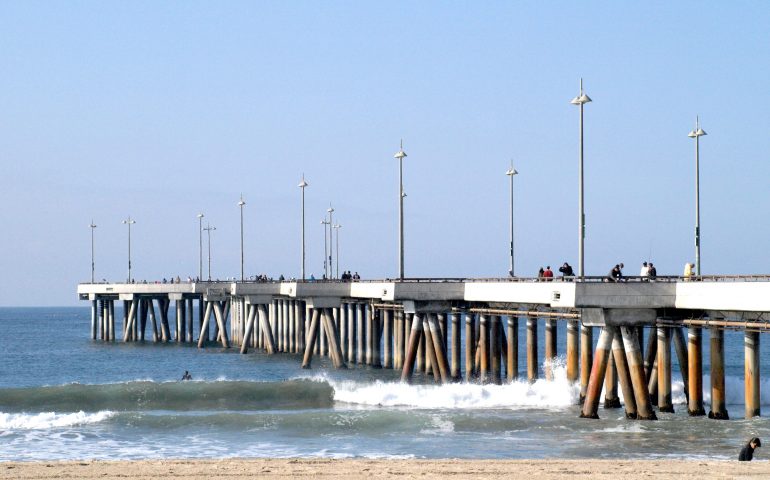
[…] Fishing Pier Pier Fishing In California File Type = jpg Source Image @ pierfishing.com Download […]
This is Great info
Thank You
The scenery here is beautiful!
A little store offers basic support to the physical man, and bait and tackle can be bought or rented.
Sounds like a cool pier! I like that they thought about making it accessible for everyone, even those in wheelchairs. Double railings are a great idea too, no more slimy railings! I’d check it out if I were ever in the area.
This is awesome. I’m glad to check this for the great content.
Che posto interessante! Non sapevo che il molo fosse stato ricostruito dopo i danni di El Nino. Quelle ringhiere doppie e più basse sono davvero un’ottima idea per tutti. Mi piacerebbe andarci a pescare un giorno!
This sounds like a good idea, Do we have to pay for us to go fishing in Venice fishing pier?
What a rollercoaster for the pier! The swift closure and gloomy initial dive reports had me worried, but it’s amazing that the ocean floor and pilings held strong. Reopening in 2006 sans restrooms and tackling termite-damaged railings in 2008? That’s wild—termite pier damage is a first!
A fascinating blend of history and practical angling insights! The dual rail design and accessible sections are brilliant innovations. Kudos for capturing Venice’s resilient bohemian spirit and the pier’s unique role in SoCal fishing culture. The shark releases and community preservation stories hooked me!
Venice Fishing Pier’s innovative designs, like the double rail and ADA-friendly sections, underscore its enduring appeal. A vibrant hub of diverse anglers and thrilling catches—from shark encounters to cultural tales—your vivid account captures its gritty charm and resilience over decades. A must-read for coastal enthusiasts!
Wow, that’s a cool history! I didn’t know the Venice Pier used to be so different. The fishing pier sounds really well-designed now, especially with the lower railings for wheelchair access. Good on them!
This write-up brings back great memories! Venice Fishing Pier is a gem on the Gulf Coast—whether you’re casting a line or just soaking in the sunset. The thoughtful design touches, like the double railings and accessible cutouts, show real care for all visitors. And Sharky’s on the Pier? Perfect spot to wrap up the day. Can’t wait for my next visit!
Absolutely love this spot! Venice Fishing Pier has that perfect blend of laid-back vibes and fantastic fishing. Nothing beats dropping a line while enjoying those breathtaking Gulf sunsets. Plus, grabbing fresh seafood at Sharky’s afterward is always a win. Thanks for highlighting this iconic Florida fishing spot!
Ah, the Venice Fishing Pier! It’s like the Hollywood of fishing spots—everyone thinks they can catch a big one, but sometimes you just reel in a story instead. And Rojas is basically the fishing version of a neighborhood watch—keeping an eye on everything while managing to throw an impressive BBQ on the side. Just make sure to keep your lines in check, or you might end up being part of a fishing soap opera with all that chaos!
What an interesting place! I didn’t know the pier was a reconstruction. I really like the ideas to make it accessible to everyone, especially the part for wheelchairs.
This looks like a great resource for planning a trip to the Venice Fishing Pier! I appreciate the detailed information provided. I’ll definitely keep this in mind for my next fishing adventure.
This looks like a great resource for planning a trip to the Venice Fishing Pier!
Thank you for sharing this great article.
“Your vivid portrayal of Venice Pier’s evolution and its vibrant community shines through historical anecdotes and practical fishing insights. The emphasis on inclusive design, like the lowered railings, and the blend of bohemian culture with angling passion is captivating. Kudos for highlighting this unique urban fishing gem—its resilience mirrors the spirit of its anglers!”
My experience with J4L Slovenian Brides has been very positive. The agency provides a curated selection of Slovenian women who are genuinely seeking love and companionship. The profiles are detailed, and the communication tools make it simple to connect. I value their honest approach and the emphasis on safety and respect. Their team guides you through every step, making the process less stressful. It’s clear they prioritize genuine relationships over quick matches. If you’re serious about finding a Slovenian bride, J4L is definitely worth considering. Their professionalism and personal touch make the journey to love more accessible and enjoyable.
This place is recommended by my friends!
An engaging blend of history and practical details, your piece captivates with Venice Pier’s innovative designs, rich heritage, and thriving angling scene. The vivid fishing tales and thoughtful accessibility features highlight its enduring appeal. Well-researched and inspiring—thank you for sharing this coastal treasure!
Impressive blend of innovative design (dual railings, accessible features) and rich fishing culture! The Venice Fishing Pier’s historical resilience and community spirit shine through its vibrant angling scenes and eco-conscious structure. A must-visit coastal gem!
never knew the Venice Pier was rebuilt. The wheelchair accessibility and bait cutting railing sound like great additions.
Interesting post! Thanks for sharing.
Kudos on this rich celebration of Venice Fishing Pier’s resilience! Your vivid contrasts of its past (Abbot Kinney’s decay to today’s inclusive design) and ecological diversity (halibut, bat rays, even great whites!) alongside human stories – from Synanon’s chaos to Rojas’ leadership – beautifully capture its enduring soul. What a testament to coastal adaptation! Thrilled to see wasted potential transformed into community treasure.